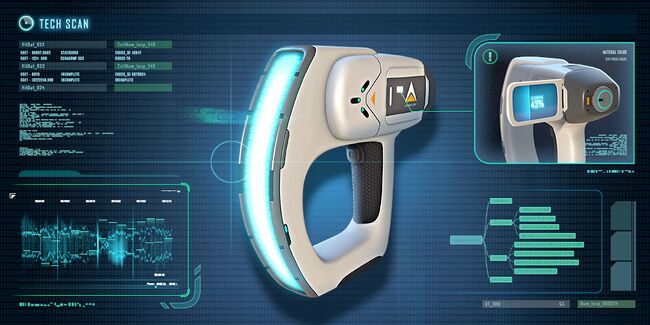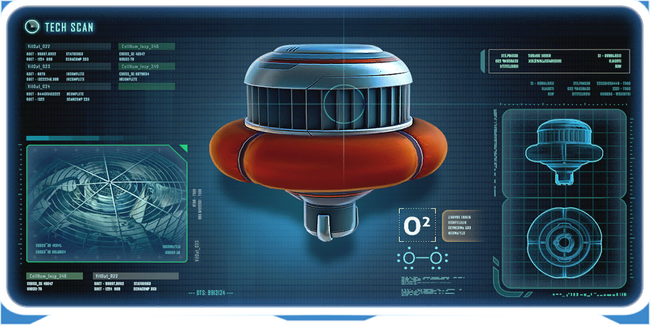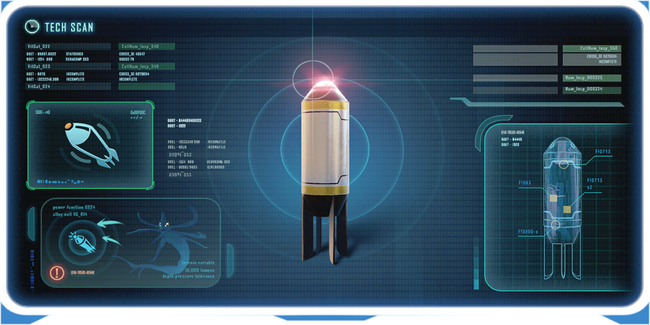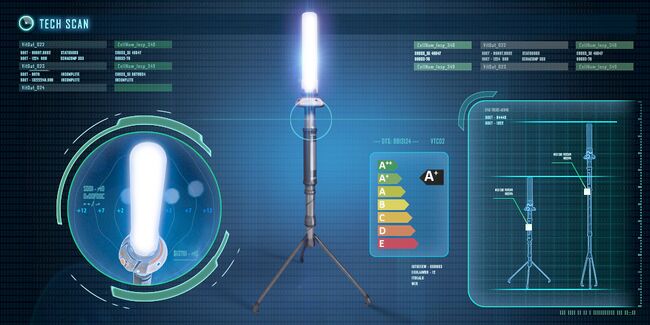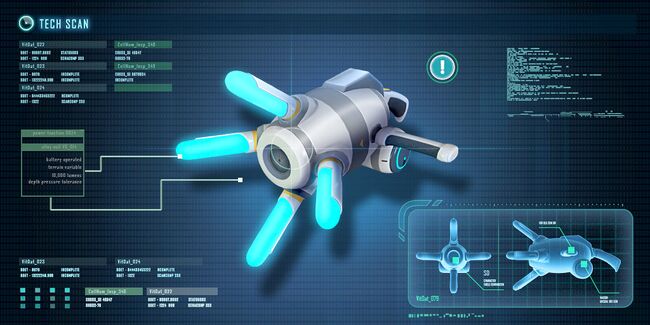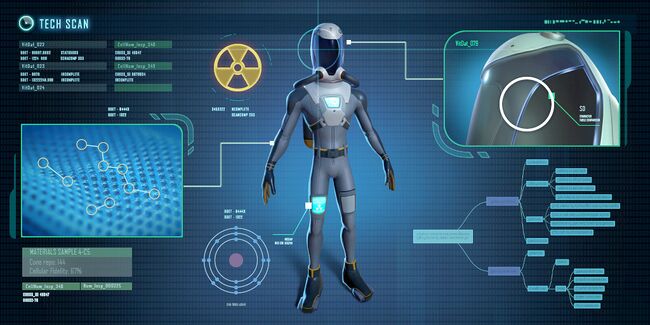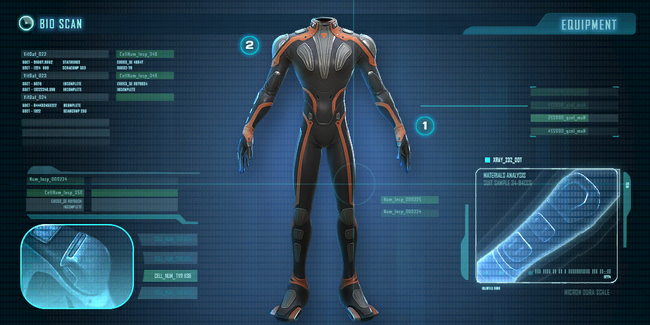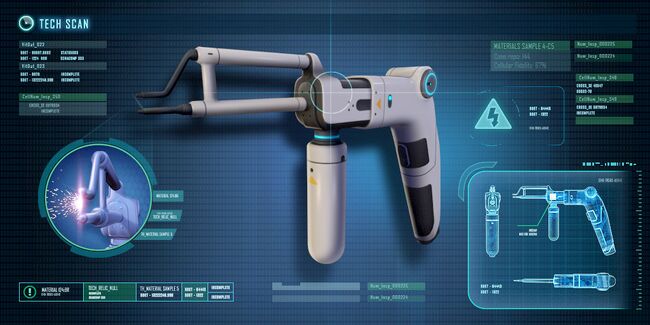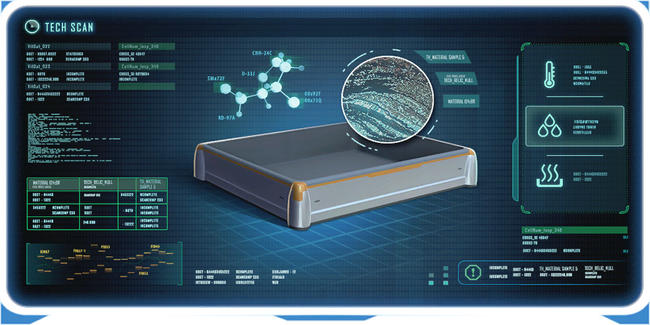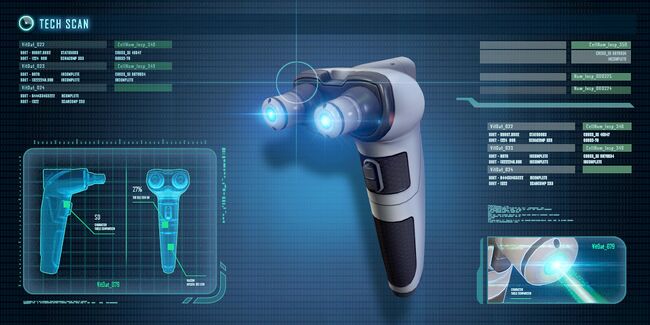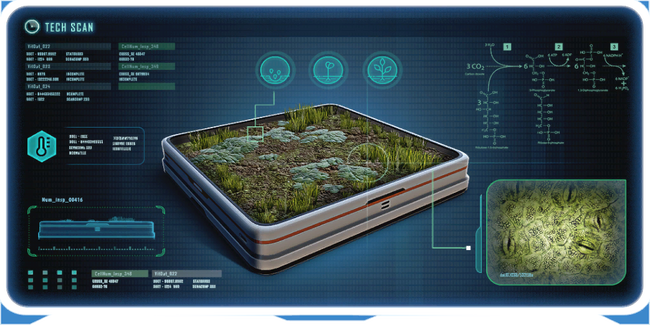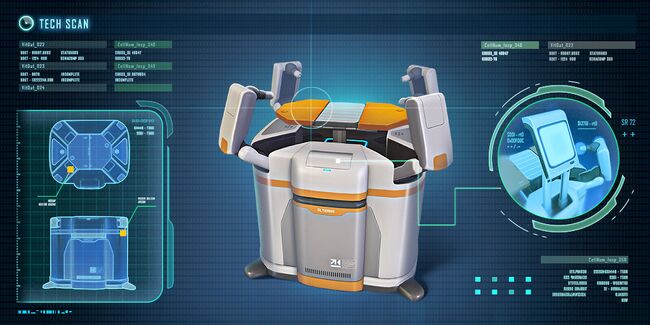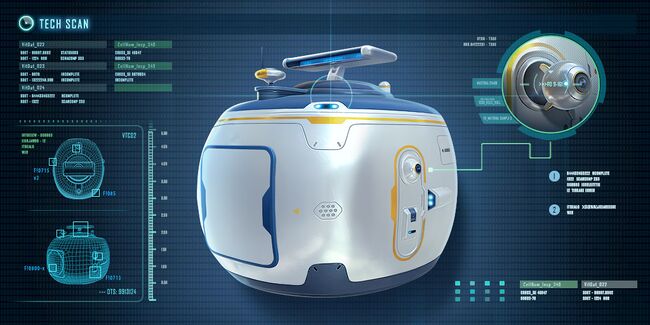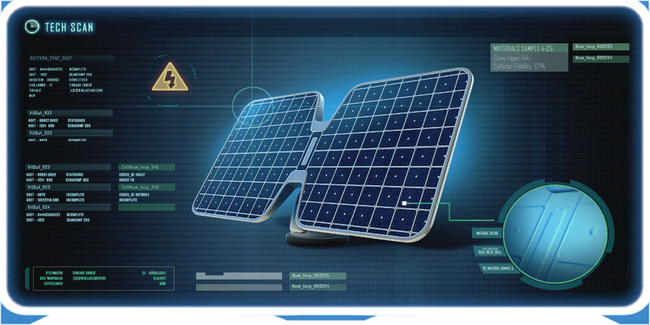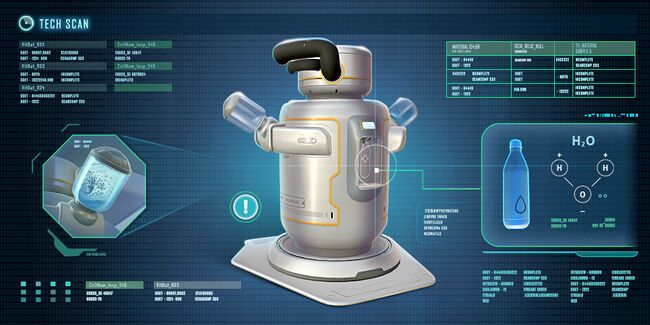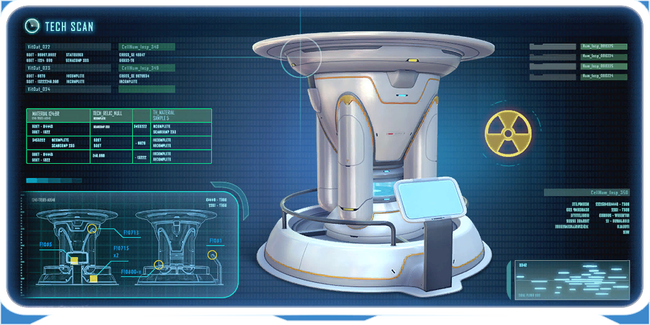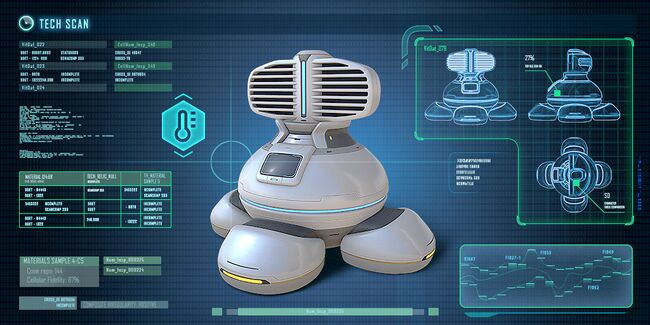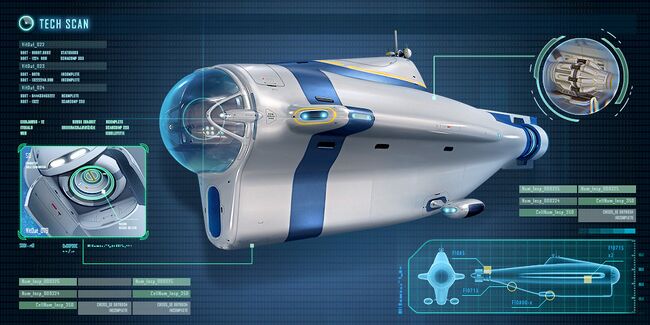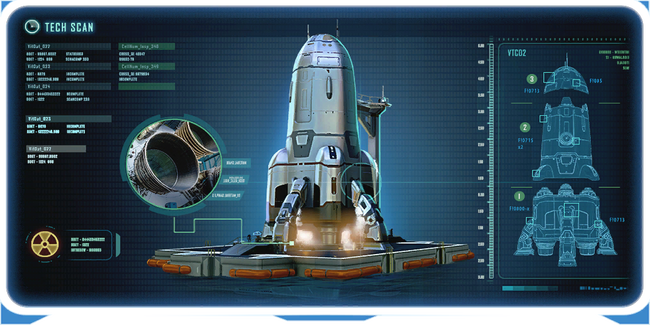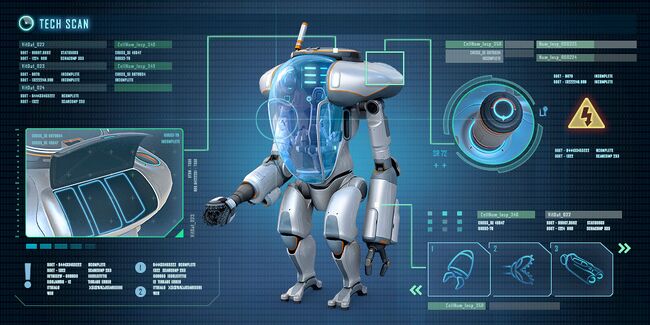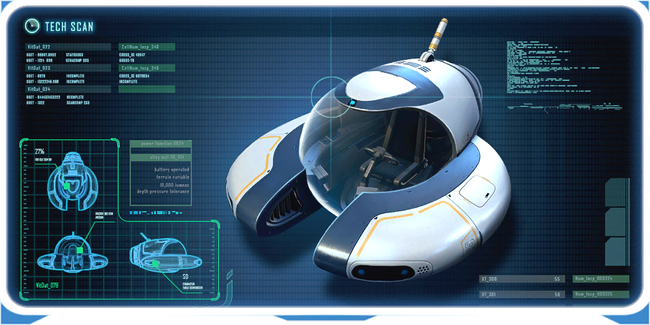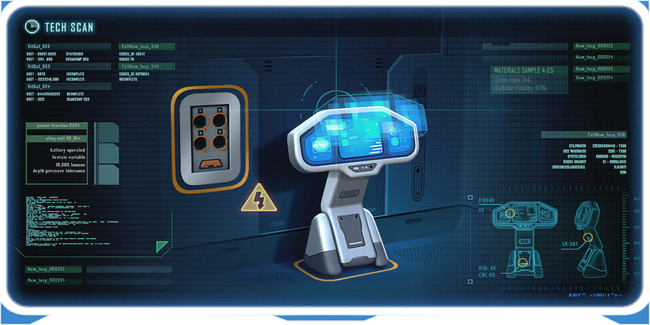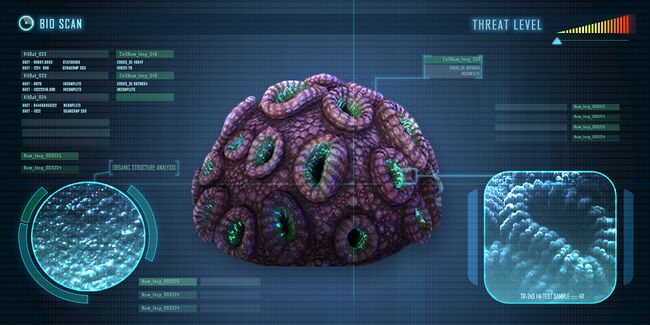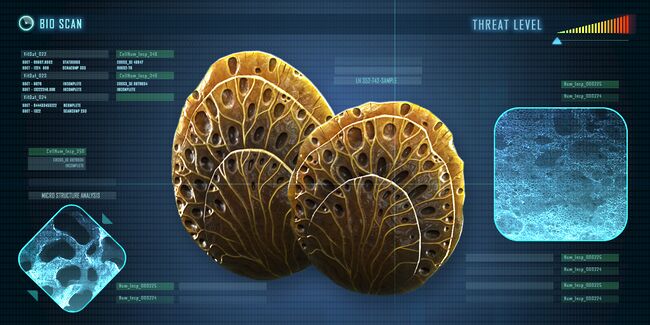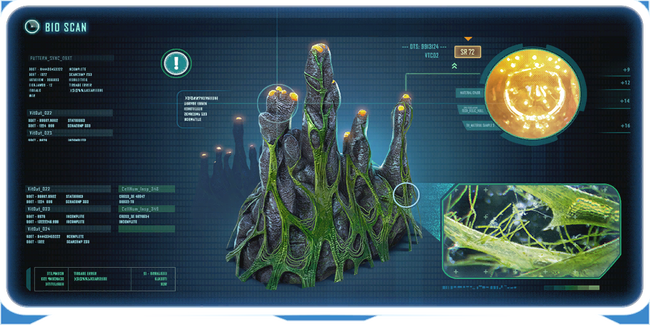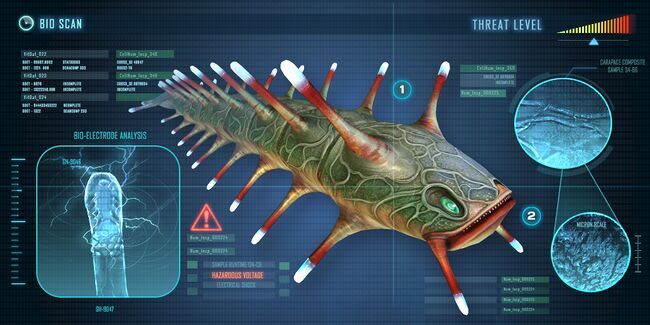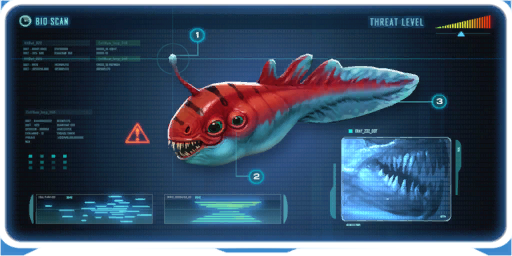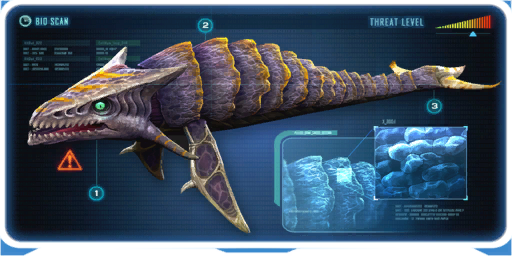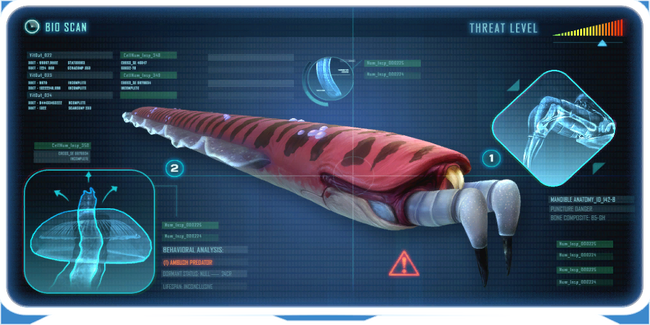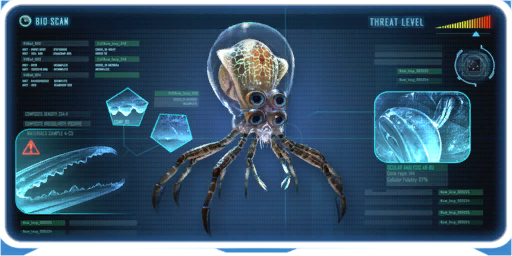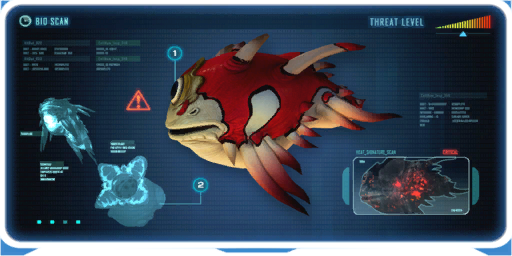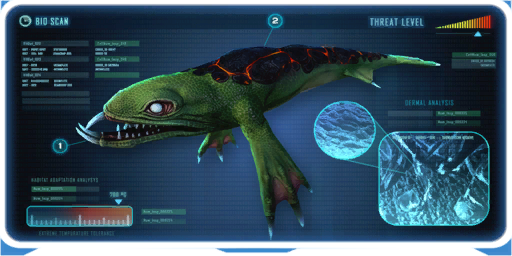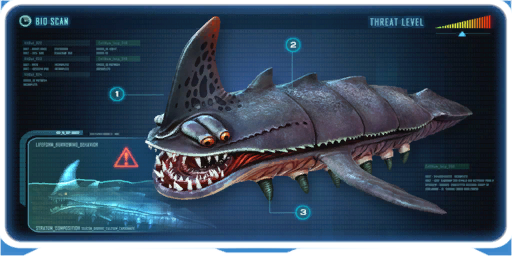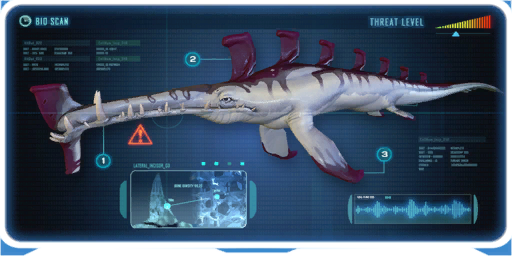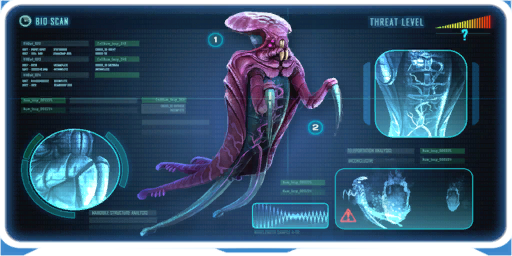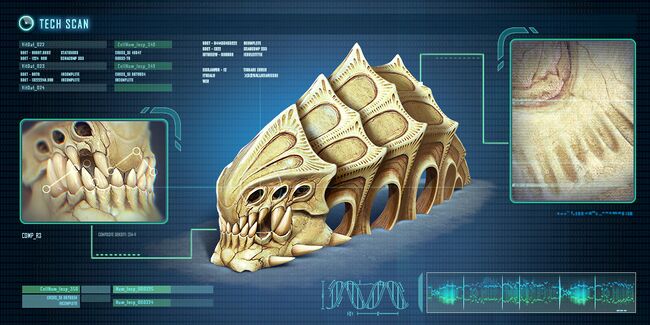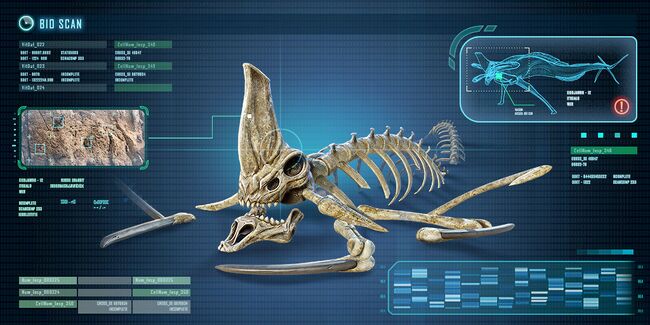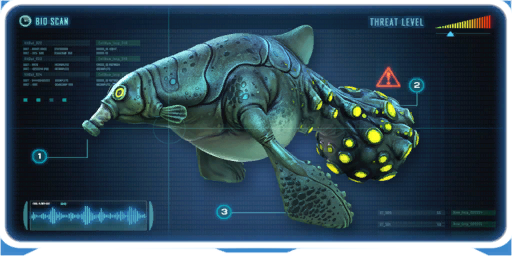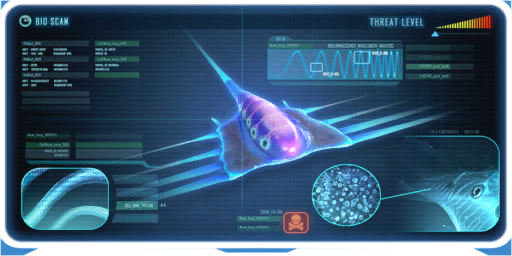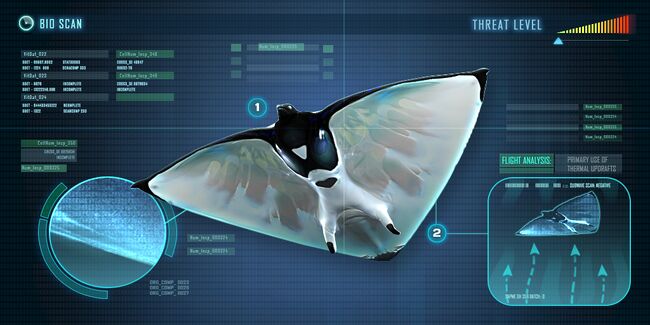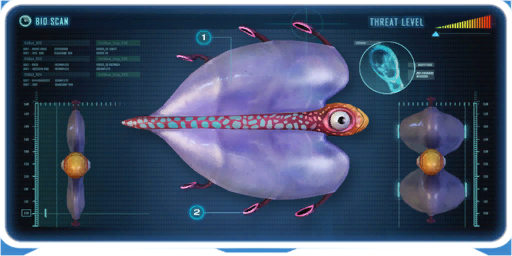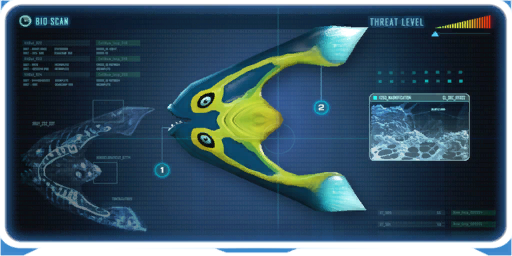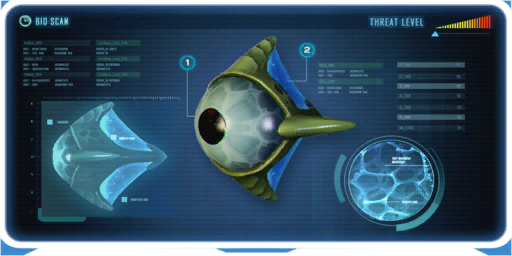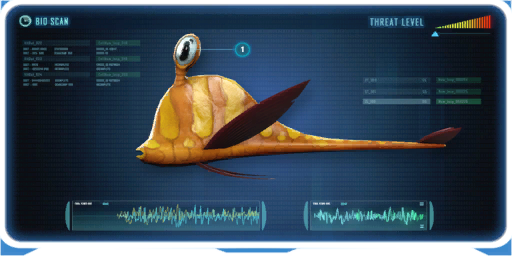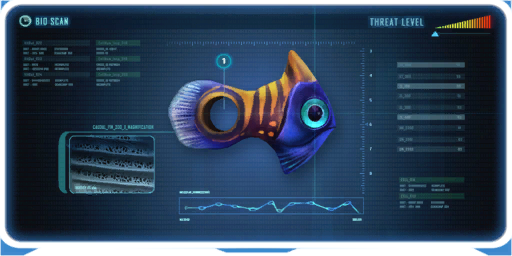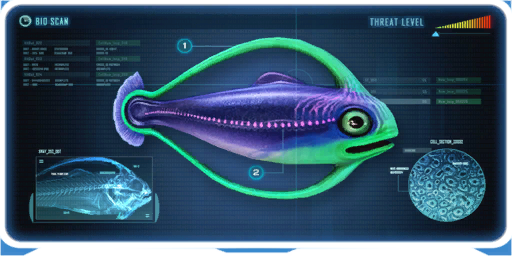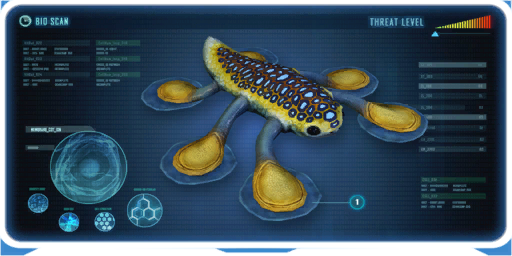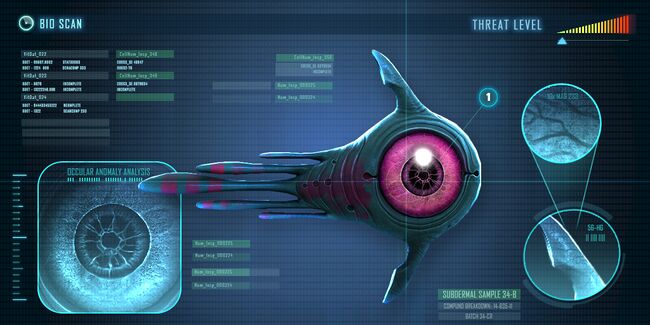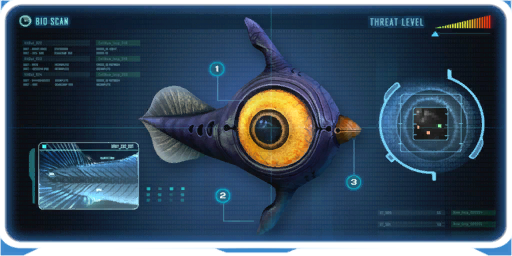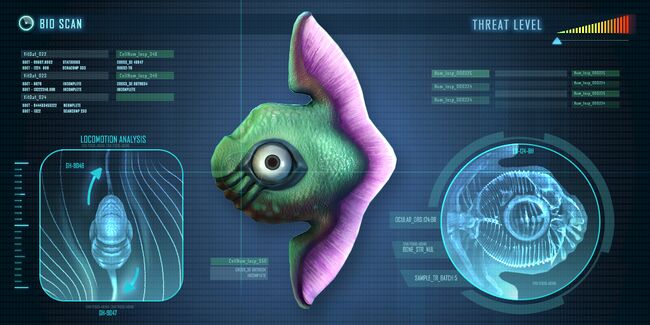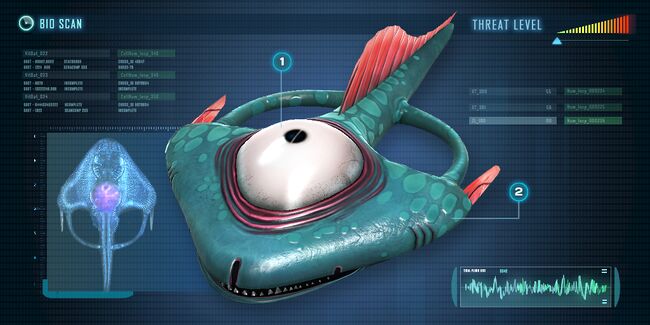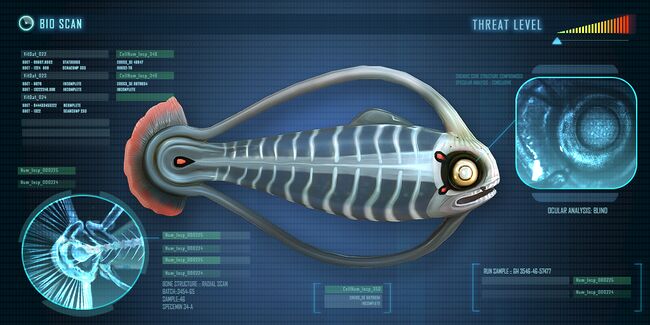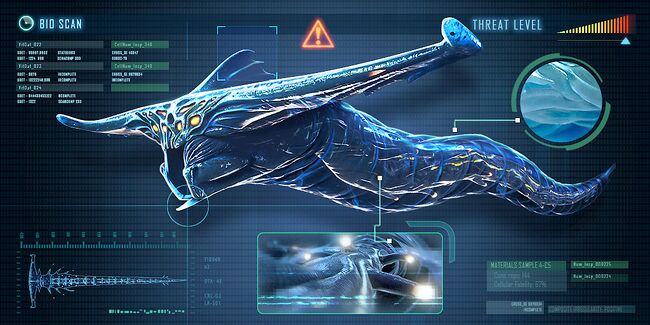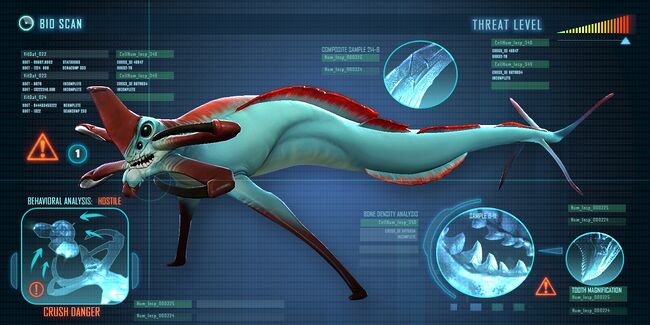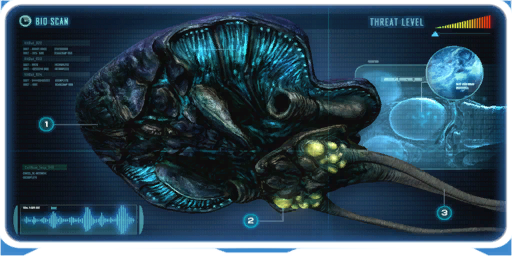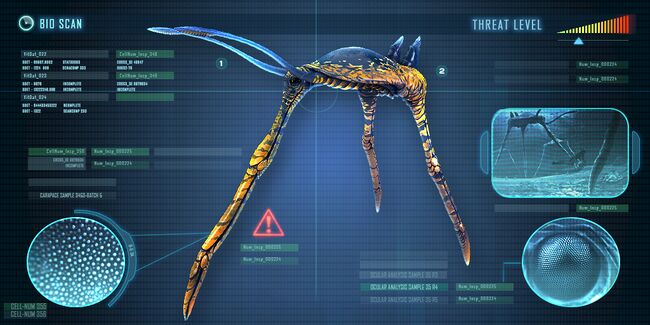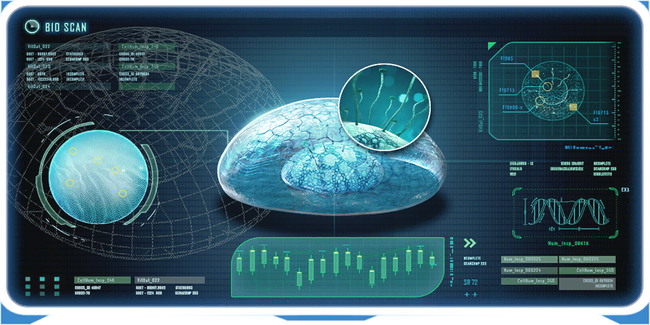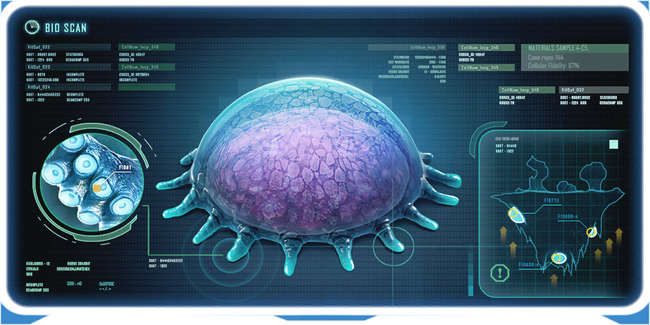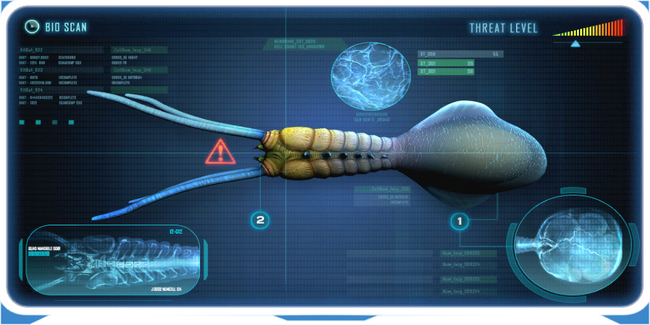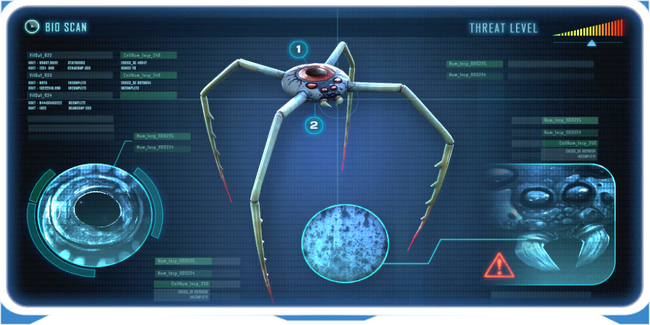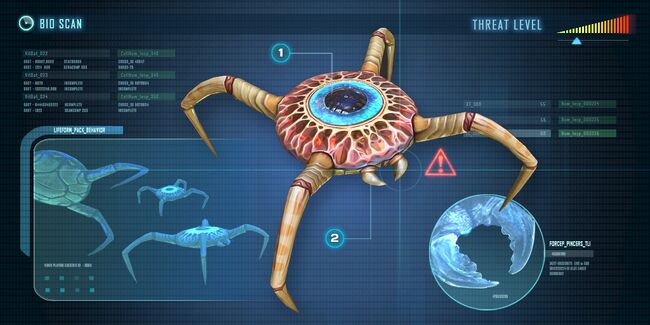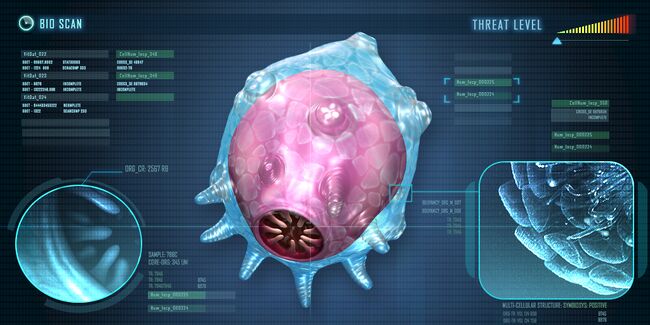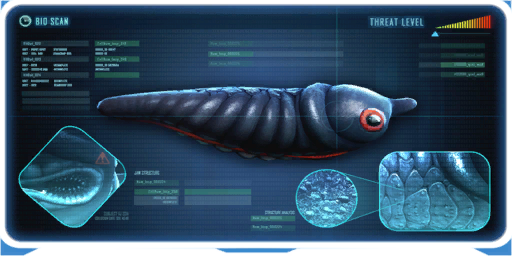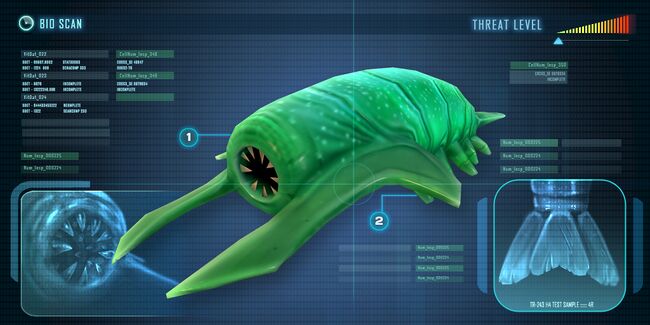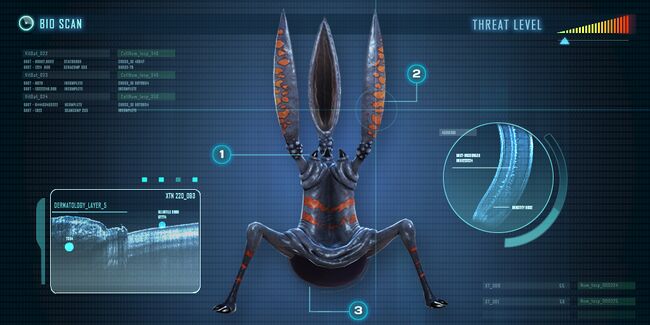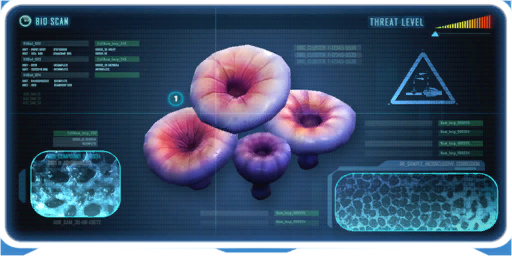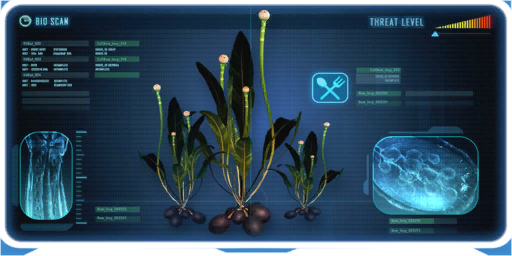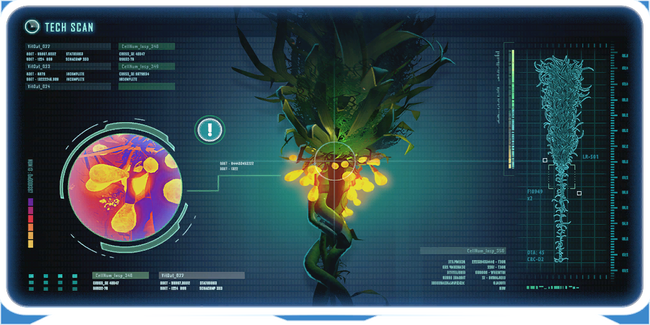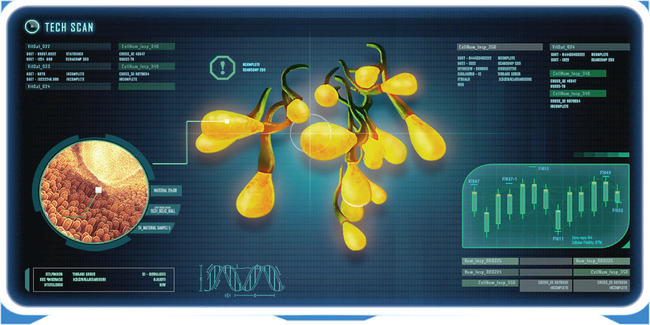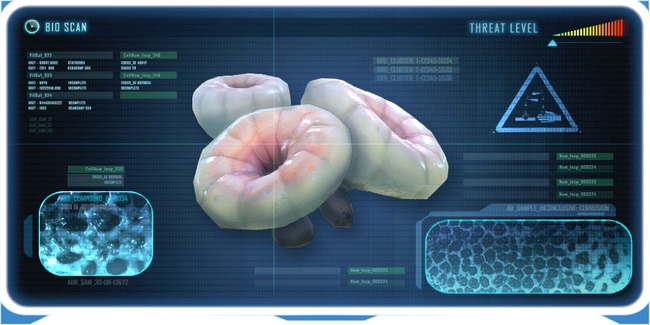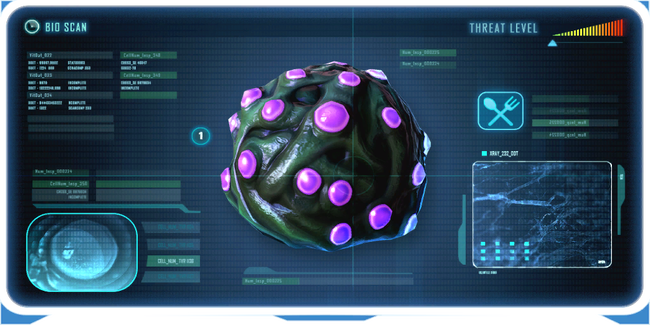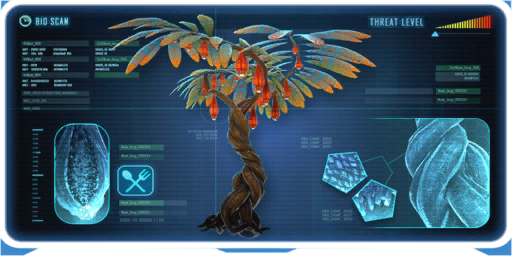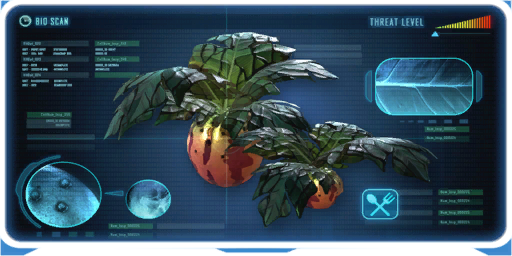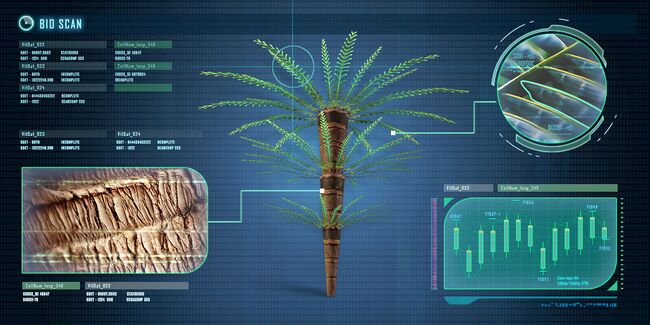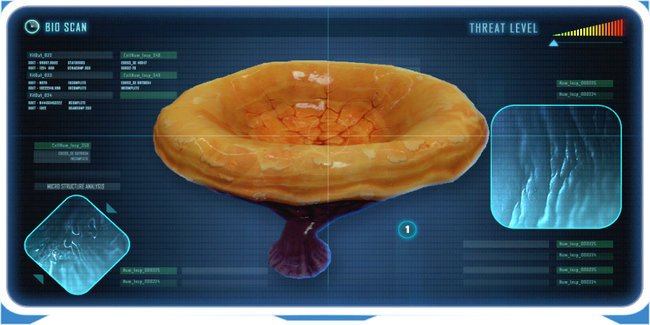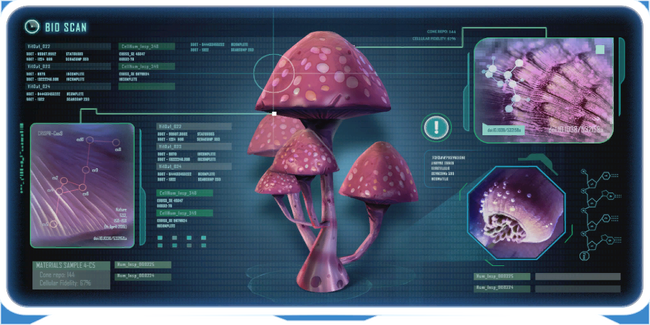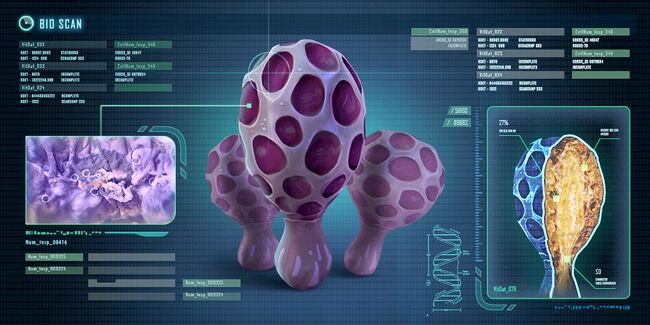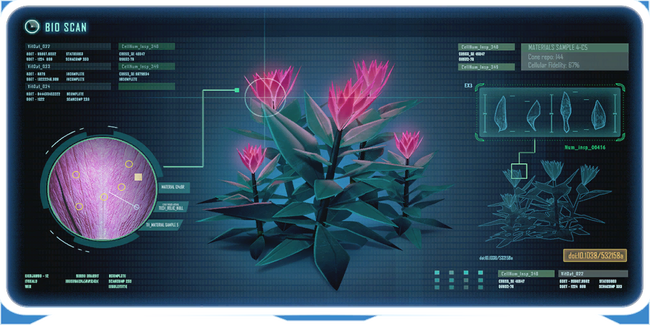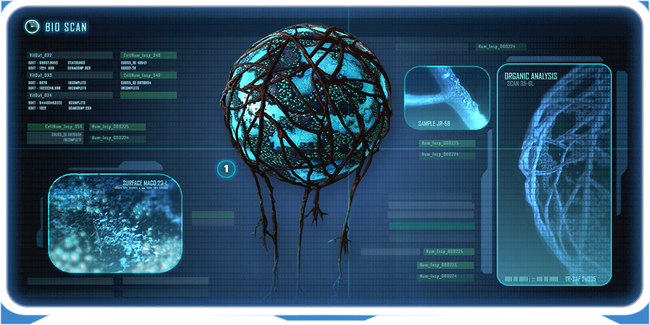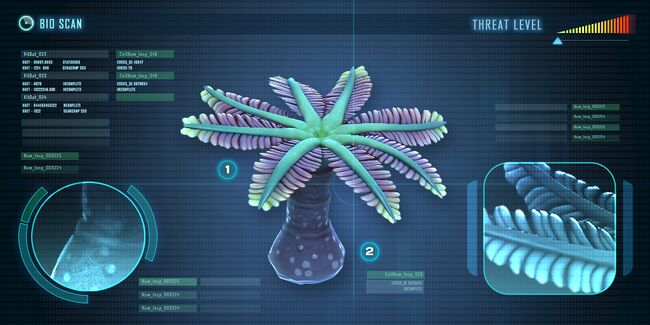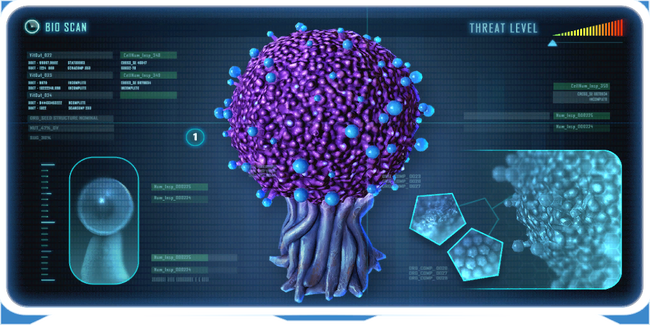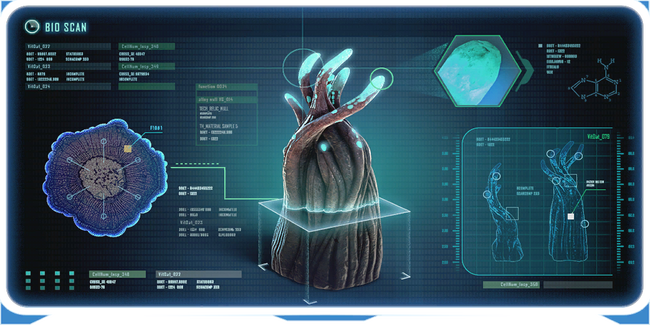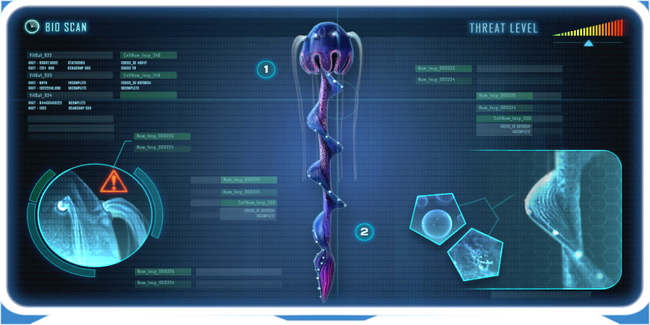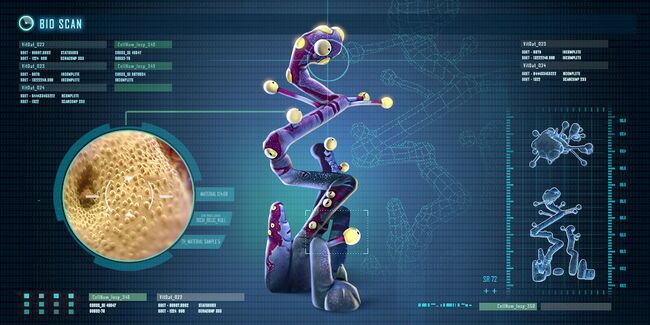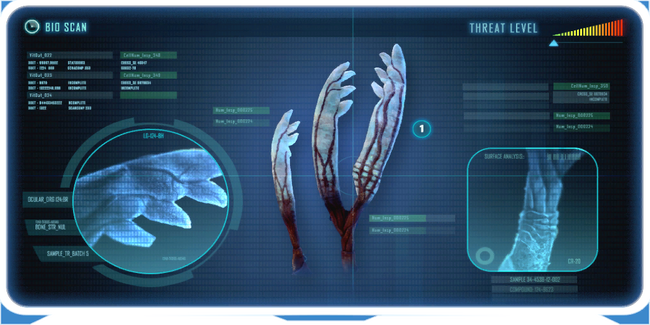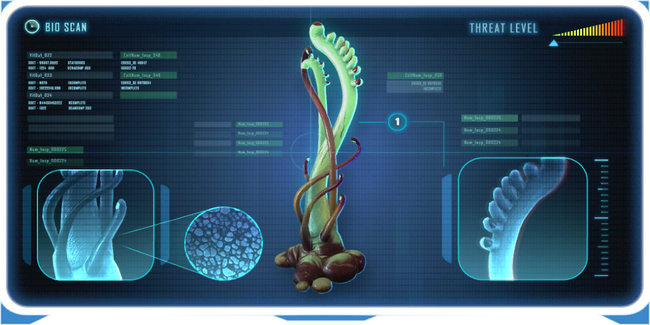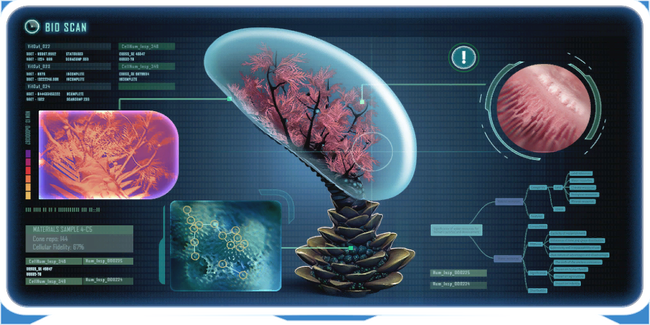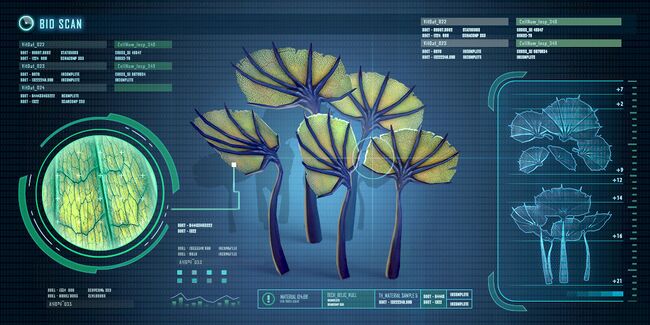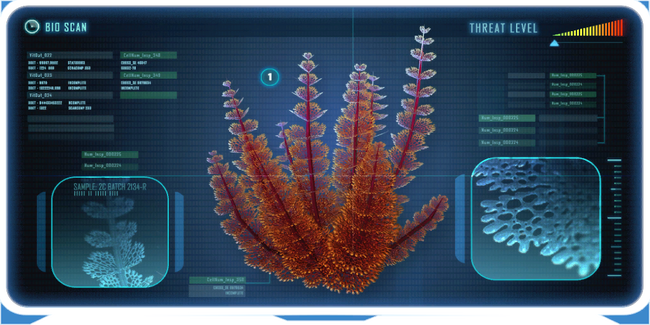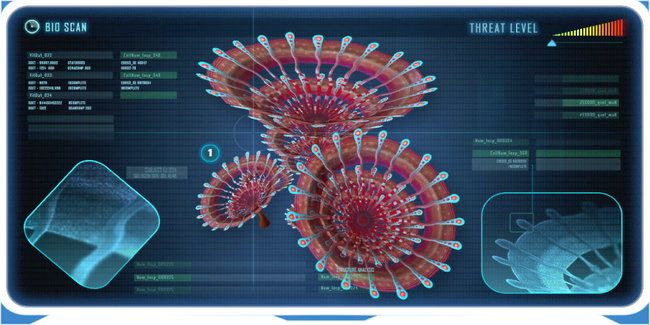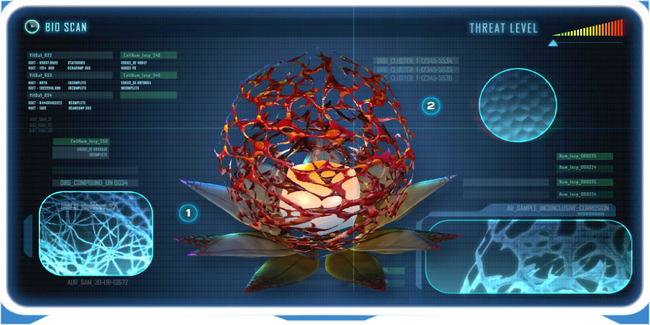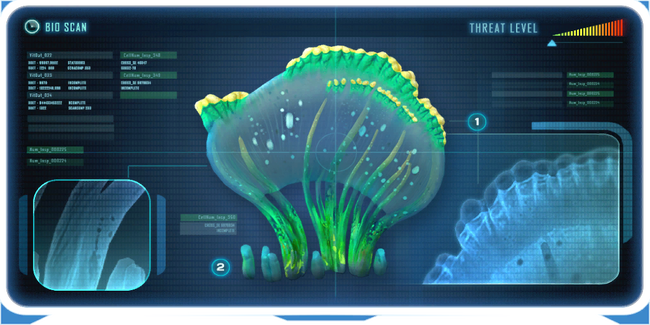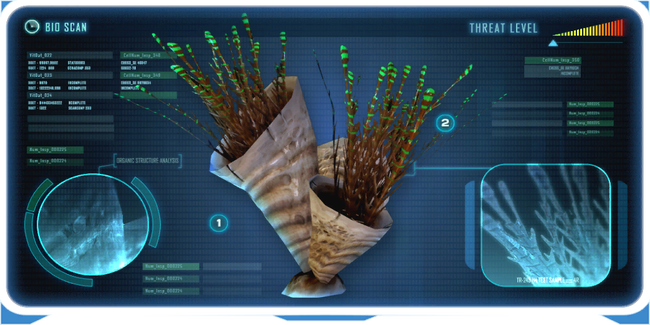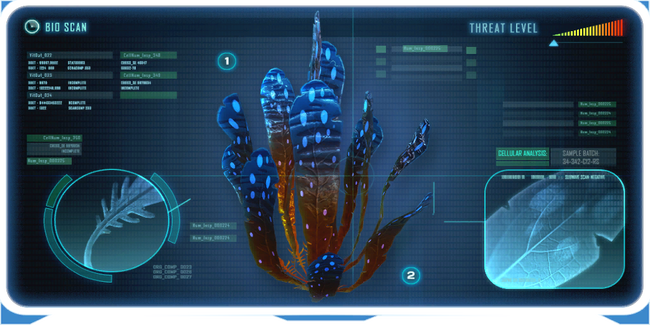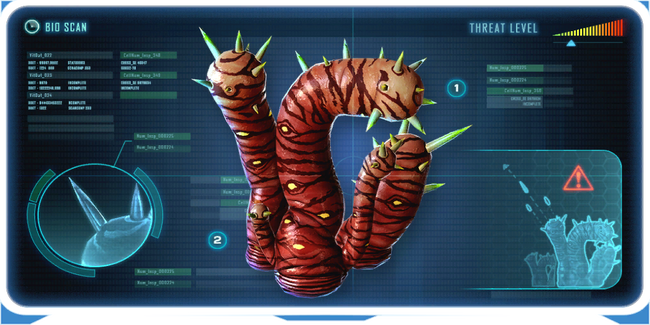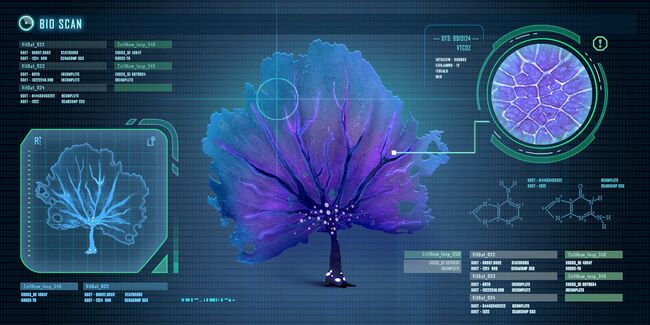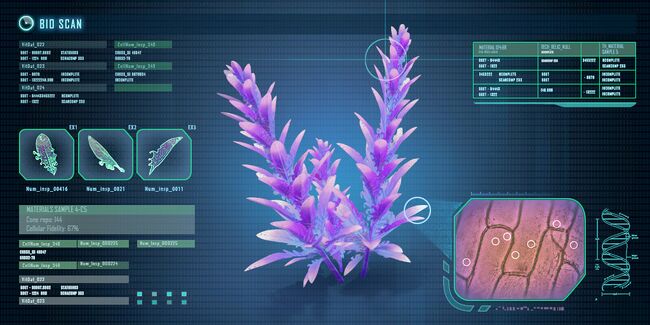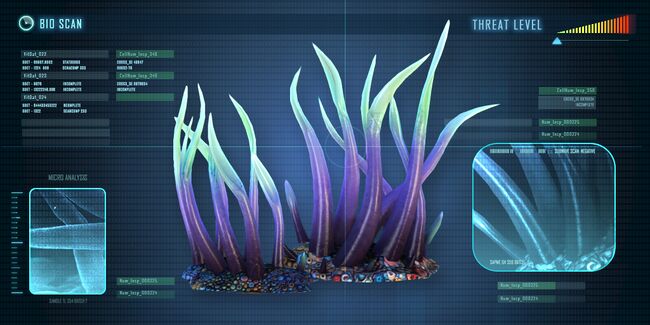Databank (Subnautica)

|
Read at own risk This article contains unmarked spoilers. Players new to the game would want to avoid or be cautious toward this article. |
The Databank is the encyclopedia of entries that are visible on the PDA.
Advanced Theories
| Alien Eggs |
| <poem>This breaks without the invisible font. Don't ask.
Evidence suggests that a substantial number, if not all of the local species reproduce through egg-laying. Eggs can be found resting on the seafloor, buried beneath detritus, or even wedged into cracks in the rock. Different species likely favor different biomes as their nesting grounds. Eggs discovered in the wild are in some form of natural stasis, likely awaiting ideal conditions in which to hatch, or the delivery of some vital enzyme which will kick start the process. It is impossible to calculate the species of the egg from the exterior, however it may be possible to stimulate a hatching response if an egg is relocated to a suitable alien containment unit.</poem> |
| Source: Pick up Alien Egg |
| Enzyme Host Peeper |
| <poem>A peeper specimen was observed emitting a faint, fluorescent enzyme trail, and engaging in unusual behavioral patterns.
- Peeper is actively approaching other creatures, including predators Chemical Analysis of Enzyme: Assessment: Recommend further research into enzyme origin</poem> |
| Source: Scan Peeper carrying Enzyme 42 |
| Specimen with Symptoms of Infection |
| <poem>This organism is displaying signs of a bacterial infection.
- Bright green blisters are forming networks around the infection sites WARNING: May be contagious. Avoid. Do not under any circumstances consume the flesh.</poem> |
| Source: Scan Infected Fauna |
Blueprints
Equipment
| Air Pumps |
| <poem>Air pumps can be used to pipe breathable air to a remote location.
- The base-attached airpump can be built at a compatible habitat, and will source oxygen directly from the habitat's oxygen generator |
| Source: Unlocked by default |
| Creature Decoy |
| <poem>This advanced deployable is a catch-all solution for mimicking the behavior of a living creature, for purposes of scientific research or predator evasion.
- Vibrates, cycles air and water, and sends out randomized, high-frequency sound waves to emulate a living organism |
| Source: Unlock Creature Decoy Blueprint |
| Handheld Scanner |
| <poem>The essential science and survival tool, the scanner can be used to add new blueprints to memory, and analyze unknown entities.
It emits electromagnetic radiation in the specified direction, which is reflected by the environment and then analyzed to determine the physical make-up of the targeted object. It has four primary functions. Blueprint Adquisition: Organism Analysis: Medical Analysis: Self-Scan: 'The Alterra Spectroscope Scanner - Understanding the world so you don't have to.'</poem> |
| Source: Unlocked by default |
| Laser Cutter |
| <poem>The ultra high frequency laser cutter is tuned specifically to cut through titanium and plasteel based materials at a thickness of up to 10cm. This makes it an essential tool for construction, salvage and rescue operations, but ineffective on natural obstacles.
'The Alterra Laser Cutter: Who called the locksmith?'</poem> |
| Source: Scan Laser Cutter |
| Light Stick |
| <poem>A mobile, battery-powered LED light, which provides low-level lighting in a 360 degree area, and can be attached to most surfaces.</poem> |
| Source: Scan Light Stick Fragments |
| Propulsion Cannon |
| <poem>The propulsion cannon allows technicians to manipulate gravitational forces at ranges of up to 20m. It is commonly used in construction and mining to move materials.
Operating Instructions: 'The Prop Cannon: Some species are telekinetic. For everyone else, there's Alterra.'</poem> |
| Source: Scan Propulsion Cannon Fragments |
| Radiation Suit |
| <poem>This suit fully protects against the effects of radiation during land, sea and space exploration.
- Safety rated up to 400 Sv/hr 'The Radiation Suit: A necessary precaution in a post-MAD world.'</poem> |
| Source: Unlock Radiation Suit Blueprint |
| Reinforced Dive Suit |
| <poem>This suit is reinforced with synthetic fibers to reduce incoming physical and thermal damage.
- Shock absorption reduces physical impact velocity by approximately 50% 'The Reinforced Dive Suit: Why take chances, when you can take Alterra?'</poem> |
| Source: Unlock Reinforced Dive Suit Blueprint |
| Repair Tool |
| <poem>The repair tool can be targeted at any common device - control panels, habitat modules, radios etc. - to stitch wires and seams back together at the atomic level. All good technicians keep one of these under their pillow.
Most people don't care why it works, just that it saved their life that one time - but in case you're curious, it combines scanner and fabricator technologies to determine the proper specifications for the targeted object, and then rearranges the available physical material to match the original specs. 'The Alterra Repair Tool: Get your fix.'</poem> |
| Source: Unlocked by default |
| Stasis Rifle |
| <poem>The stasis rifle uses patented technology to slow time around an entity to as near to a full stop as the laws of physics will permit, essentially anchoring the target in place without affecting its internal workings. It is designed to facilitate scientific and engineering operations by expanding the window of opportunity for action in time-sensitive scenarios.
The stasis rifle features an independent, replaceable power cell, and the trigger may be held down to increase the area of effect and duration. Common applications include: NB May not function correctly on larger lifeforms. 'The Alterra Stasis Rifle: Life's fast. Why not put it on pause?'</poem> |
| Source: Scan Stasis Rifle Fragments |
| Stillsuit |
| <poem>The industry standard stillsuit is designed to minimize water loss while exploring hostile environments, by filtering and recycling bodily fluids.
- Reclaimed water is stored in containers for later consumption, normal production rate is 2 bottles per day 'The Stillsuit: Because drinking reclaimed urine is better than death by dehydration.'</poem> |
| Source: Unlock Stillsuit Blueprint |
| Time Capsule |
| <poem>These sturdy containers are designed to store written and photographic evidence for later retrieval, in addition to a number of small items. Time capsules are often fabricated by marooned survivors seeking either to aid those who find themselves in the same predicament in the future, or to leave evidence of their plight which may be found long after their bodies have disintegrated.
Most emergency escape vehicles are equipped with a time capsule by default, usually found in the cockpit, and be jettisoned on take off. Alterra requests time capsules be stocked with tools and resources which will aid those who may discover them in the future.</poem> |
| Source: Scan Time Capsule |
Habitat Instalation
| Alien Containment |
| <poem>Despite huge, Alterra-led advancements in stellar technology, exploring new worlds still has its challenges, and alien lifeforms are one of them. That's why we built the alien containment unit. The unit is designed primarily to breed larger or more dangerous species.
Technical Provisions: Breeding Tips: Warnings: |
| Source: Unlock Blueprint or Scan Alien Containment |
| Aquarium |
| <poem>The aquarium is designed to hold and sustain up to eight small aquatic organisms, and fits inside a regular multipurpose habitat room.
Aquatic creatures make up 70% of all known species, making the aquarium a commonly deployed tool in many exploratory operations. It is just as often used to house livestock for later consumption as it is to hold specimens for xeno research. An automated environment regulation system means there's no need to feed or care for your subjects. NB Due to its size the regular aquarium is not rated for breeding applications, and creatures are highly unlikely to mate. Construct a full size alien containment unit for this purpose.</poem> |
| Source: Unlocked by default |
| Bulkhead Door |
| <poem>The bulkhead door is designed to separate compartments while reinforcing structural integrity with its solid titanium frame. The door can be opened and closed to seal off compartments in the event of fire or flooding, or simply for privacy.</poem> |
| Source: Scan Bulkhead |
| Exterior Growbed |
| <poem>Advanced synthetic soils allow this growbed to support a huge variety and quantity of alien plant life, and it can be installed anywhere on land or underwater where there is space.</poem> |
| Source: Scan Exterior Growbed |
| Fabricator |
| <poem>Fabrication technology is the power to rearrange matter at the atomic level. It was the catalyst behind the great expansion, and remains the backbone of the modern world.
Fabricators come in all shapes and sizes, but the most common are small enough to be wall-mounted, and are used for everything from constructing everyday implements to cooking dinner. It is common today for households to keep a store of generic base materials on hand for any eventuality.</poem> |
| Source: Unlocked by default |
| Floodlight |
| <poem>The standard issue floodlight is designed to focus a bright beam of light in a single direction, useful in all kinds of industrial and emergency operations. Functions in all known environments.</poem> |
| Source: Scan Floodlight |
| Habitat Builder |
| <poem>The Alterra handheld habitat builder has been an essential tool of xenoscientists, colonists and emergency relief crews across 11 different trans-govs for more than 50 years.
- Habitat modules are hermetically sealed from the outside environment Quick Start Guide: Primary habitat systems like oxygen generation and flood control, as well as modules like the fabricator draw power and will not function without it. Additional compartments reduce overall hull integrity, depending on the external pressure. 'Quick-Build Habitats: A home far, far away from home.'</poem> |
| Source: Unlocked by default |
| Interior Growbed |
| <poem>Designed for use exclusively inside regulated habitat modules, the interior growbed is more compact than the outdoor version, and features a hydroponic nutrient delivery system.</poem> |
| Source: Scan Interior Growbed |
| Modification Station |
| <poem>Where the standard fabricator atomically rearranges raw materials to form complex devices, the mod station is able to combine complex devices to enhance their function. Most industrial vessels are fitted with a complement of equipment modification stations, which enable engineers to adapt their tools on the fly.
To conserve hard drive space the modification station is excluded by default from most personal emergency blueprint libraries; however extreme environments such as ocean and desert class planets may necessitate the adaptation of basic survival tools for unanticipated applications. For this reason access to a mod station is always recommended.</poem> |
| Source: Scan Modification Station Fragments |
| Moonpool |
| <poem>The moonpool is an essential module for long-term exploration. Its primary function is as a dry dock for small vehicles such as the Seamoth and Prawn suit.
The large central chamber contains a pressurized pool which provides ready access to the surrounding waters, and comes as standard with equipment for raising and recharging a vehicle. When outfitted with a vehicle modification station the moonpool can be used to build and equip vehicle upgrades. Ratings:
- Dimensions: 16m x 10m x 5m |
| Source: Scan Moonpool Fragments |
| Planter & Pots |
| <poem>Interior planters come in a variety of configurations, and allow for most plant species to be grown in small numbers. For decorative or botanical use.</poem> |
| Source: Scan Plant Pots |
| Scanner Room |
| <poem>This advanced habitat module can transform a small outpost into a burgeoning science and exploration station.
- A 3D display in the center of the room stores local topographical data |
| Source: Scan Scanner Room Fragments |
| Solar Panel |
| <poem>Solar power is the most prevalent power source in the galaxy, and so it is no accident that the standard solar panel is the default means of powering a habitat. A power source is a requirement of habitat oxygen generators and other onboard modules.
- Provides limited power for small outposts and survival habitats |
| Source: Unlocked by default |
| Spotlight |
| <poem>A permanent lighting solution developed for installation on existing habitats and facilities.
- Automatically rotates on a 180 degree arch |
| Source: Scan Spotlight |
| Water Filtration Machine |
| <poem>The filtration system draws water unfit for human consumption from an external source, atomically splits it into its constituent parts, and outputs consumable liquid water and salts, while disposing of any harmful by-product. It can be built in any compatible habitat module, but has substantial power requirements.
'The Alterra Water Filtration System: Any liquid into pure, refreshing, pH-balanced water? Yes sir, ANY liquid!'</poem> |
| Source: Scan Water Filtration Machine |
Power
| Bioreactor |
| <poem>On planets where organic matter is plentiful but sunlight is not, a reliable bioreactor will frequently prove the most efficient power solution.
- May be installed in any multipurpose habitat room 'The Bioreactor: Totally organic.'</poem> |
| Source: Scan Bioreactor Fragments |
| Nuclear Reactor |
| <poem>Renewable energy sources will usually be sufficient for maintaining a small outpost. For everything else there's nuclear power.
- Powered by up to four replaceable uranium reactor rods Nuclear is ideal for energy-intensive operations such as: |
| Source: Scan Nuclear Reactor Fragments |
| Thermal Plant |
| <poem>The first rule of survival in hostile environments is to work with the resources available. If it's 800 degrees outside and you're in danger of burning to death at any moment you may as well get some cheap, reliable energy out of it.
- Converts heat energy into electricity 'The Thermal Power Plant: It's hot'.</poem> |
| Source: Scan Thermal Plant Fragments |
Vehicles
| Cyclops |
| <poem>The cyclops is the most popular and reliable deep-sea submersible in the galaxy. By comparison to the competition it can be crewed by just one pilot, hence the name.
It features: Advice for Captains: Ratings: NB The cyclops does NOT feature: |
| Source: Scan Cyclops Fragments |
| Mobile Vehicle Bay |
| <poem>The mobile vehicle bay is a deployable station equipped with fabrication drones, designed to construct small research and exploration vehicles from raw materials. It is a common tool in almost all industrial, scientific and colonization operations.</poem> |
| Source: Unlocked by default |
| Neptune Escape Rocket |
| <poem>This blueprint set was developed at Alterra headquarters specifically to get you off 4546B and back to the nearest phasegate. It takes into account local gravity, astronomical data and available resources, and is piloted by AI. It may be adapted to employ whatever power source is available - but it will require a lot of it.
It consists of five independently constructible elements: - Launch Platform: Floating platform provides a solid base from which to launch the rocket Features: Warning: Onboard AI will not launch if local threats are detected. Warning: The use of alien materials to power the craft may increase its range in unpredictable ways.</poem> |
| Source: Unlock Neptune Escape Rocket Blueprint |
| Prawn Suit (Mk.III) |
| <poem>The Pressure Re-Active Waterproof Nano Suit is a range of mechs designed to protect the pilot from extreme environments. The Mk.III is the latest iteration, and has so far only been rolled out by Alterra for their own high-value, phasegate-related operations.
- The suit is fully insulated from the outside environment 'The Prawn Suit: It's got you covered.'</poem> |
| Source: Scan Prawn Suit Fragments |
| Seaglide |
| <poem>The seaglide is a personal transportation device designed for use in oceanic environments.
- Capable of speeds of up to 36km/h in standing water 'The Seaglide: Anything that moves faster underwater is probably trying to eat you.'</poem> |
| Source: Scan Seaglide Fragments |
| Seamoth |
| <poem>The seamoth is a one-person vehicle with an independent, replaceable power cell fitted in the rear and a fully customizable design. Low power, multi-directional thrusters enable it to function equally well in sea or space environments.
Most long-range vessels carry at least two vehicles of this class to facilitate the exploration and exploitation of small astronomical bodies, however they can also be fabricated at a standard mobile vehicle bay. Ratings: Seamoths may be modified by installing upgrade modules to the access point mounted on the wing. These include: NB These modules may only be manufactured at a moonpool outfitted with a vehicle modification station. 'The Seamoth: It goes anywhere but land.'</poem> |
| Source: Scan Seamoth Fragments |
| Vehicle Upgrade Console |
| <poem>This terminal allows vehicles to be customized with different naming and color schemes, and upgrade modules.
- Must be installed in a compatible moonpool module |
| Source: Unlock Vehicle Upgrade Console Blueprint |
Data Downloads
Aurora Survivors
| Aurora Engineering Drone - Log |
| <poem>[Exiting sleep mode. Loading voice recognition. Engineer Berkeley and Chief Technology Officer Yu identified.]
BERKELEY: Drone, get me a propulsion cannon. [Repulsion cannon retrieved] CTO YU: Hey, Berkeley! Install that circuit box with that repulsion cannon and you'll punch a hole in the cargo bay. BERKELEY: Damnit, drone, I said PRO-pulsion, not RE-pulsion. Recalibrate sensors! [Sensors recalibrated] CTO YU: Sensors aren't the problem. I tweaked the program. It's like you now, it doesn't like being told what to do. BERKELEY: Drone, I know- CTO YU: His name's Albert now. BERKELEY: Albert. I know it's not your fault, but it would really help me do my job if you'd bring me what I asked for. Thanks for your time. [Propulsion cannon retrieved] BERKELEY: Thank you. Now go away. [Entering hibernation mode] BERKELEY: Boss, this hobby of yours isn't making my job any easier. Or safer. CTO YU: Maybe so, but it's all that's stopping me from being so bored I take a spacewalk in my skivvies. File:Aurora Cargo PDA1.ogg</poem> |
| Source: Pick up Abandoned PDA in the Aurora |
| Aurora Scanner Room Voice Log |
| <poem>OFFICER KEEN: The way I see it no one's to blame here.
UNIDENTIFIED CREW 1: He gave me the wrong co-ordinates! UNIDENTIFIED CREW 2: She didn't give me clear instruction! OFFICER KEEN: Okay, I'll rephrase: you've been equally incompetent. Now, we've lost time, but we're closer to the planet, so if the Degasi's out there the scan should pick it up. UNIDENTIFIED CREW 1: Why are we even helping the Mongolians? They're the competition. OFFICER KEEN: Enjoy your shore leave on Sanjei Station? Like having fuel in the tanks? Thank the Mongolians. We run the scans, we show them we didn't find anything, and we say thanks for the free dinner. Clear? UNIDENTIFIED CREW 2: Sir, there's something odd on the surface scan here. OFFICER KEEN: Turn that recorder off! |
| Source: Pick up Abandoned PDA in Northwestern Mushroom Forest Wreck |
| Captain's Log |
| <poem>Loading program: CraigMcGillSimulator.vrat
Size: 1 player (Cap'n 'Hot Dog' Hollister) Your are exploring a quiet alien backwater when the ship you arived here in implodes. It must be the aracnid kidney-poachers! Quick, what will you do? That's just what Craig McGill would do. After foraging for some hours you have collected a number of potentially farmable foodstuffs. Which will you sustain yourself with? While the starwal eggs are nutritious, the lifecycle of these vast, space-fering creatures is much too slow to sustain a farm, and besides, their mother is extremely angry with you. Craig McGill knows that there is no reasoning with a mother scorned. You are not so much torn apart as swallowed whole and disintegrated. The atoms you thought were YOU are gradually redistributed in service of the starwal's continued survival. Would you like to continue? |
| Source: Pick up Abandoned PDA in the Aurora |
| Lifepod 12 Medical Officer Danby's Crew Log |
| <poem>I'm not really a doctor. I know that's what my ID says, but I never have been. Cheated the medical exams. What does a doctor these days need to know about manually resetting bones? When was the last time a top surgeon actually cut someone open? That's what the robots are for!
Doctors these days read diagnoses off of computer readouts. For that, I'm perfectly qualified. But what good is it when I'm not connected to the main network? I'm bleeding. I've got glowing green pustules growing on my hands. I run a self-scan and it tells me I've got skin irritation. The only thing I studied in medical school was how to lie convincingly. What the hell do I know how to treat an alien disease? I think I'm actually going to die down here. File:Lifepod2 PDA.ogg</poem> |
| Source: Pick up Abandoned PDA from Lifepod 12 |
| Lifepod 13 Emissary's Voicelog |
| <poem>[Lifepod systems online.] [Passenger 07 'Emissary Jochi Khasar' has boarded the lifepod.] KHASAR: My creators, the cherishers and sustainers of worlds, give me this day my daily pleasures, as I give to those who seek pleasures from me. [Lifepod detached from Aurora OK.] KHASAR: Show me the path, in Life, Truth, and Love. For mine is the power, I am the one. On and off and on again. [Exterior hull damage sustained.] KHASAR: Life is a game, which the universe plays with itself. I am done playing as this bundle of flesh. Return me. File:Lifepod4 PDA.ogg</poem> |
| Source: Pick up Abandoned PDA from Lifepod 13 |
| Lifepod 17 Crew Log |
| <poem>Ozzy's log. It's the day of the crash. I don't know what the heck is happening. I'm scared and I'm not going outside. There are shadows in the water under the hatch but I can't tell if they're rocks, or aliens, and there's weird looking caves nearby.
The Aurora was carrying everything needed to build the phasegate: mobile vehicle bays, bioreactors, propulsion cannons... It had a cinema. There-there was a zero-G gym. My cafe. I don't understand how we're here now. I don't know why no one's coming for me. File:LifepodSeaglide.ogg</poem> |
| Source: Pick up Abandoned PDA from Lifepod 17 |
| Lifepod 19 Second Officer Keen's Crew Log |
| <poem>To all crew - If you are reading this then you have followed the automatic distress signal broadcast by this lifepod's onboard computer, contrary to my orders. I have been forced to evacuate. Your orders are to disregard my safety and attempt to reach the designated rendezvous co-ordinates at the nearest landmass. I hope to see you there.</poem> |
| Source: Pick up Abandoned PDA from Lifepod 19 |
| Lifepod 19 Second Officer Keen's Voicelog |
| <poem>CAPTAIN: Keen! This is Aurora, come in!
KEEN: This is Keen, lifepod detached okay, planetfall in 30 seconds! CAPTAIN: The computer has identified a landmass at the attached coordinates! I want you to regroup the crew there! KEEN: Understood, but- CAPTAIN: They're your responsibility now, don't let them down! KEEN: Captain, you need to evacuate! CAPTAIN: Negative, you'll need the ship in one piece if you're going to contact HQ on the long-range. I'm attempting a controlled descent. *Explosion aboard the Aurora* KEEN: Captain?! *Static* File:LifepodKeenDialog.ogg</poem> |
| Source: Pick up Abandoned PDA from Lifepod 19 |
| Lifepod 2 Chief Technical Officer Yu's Voicelog (T+2min) |
| <poem>CTO YU: Flotation devices failed!
*Sound of flooding* BERKELEY: We're flooding, evacuate! CTO YU: Wait, I can reconfigure the O₂ system to act as a bilge pump! BERKELEY: It's working! *Crash* CTO YU: OK, good news: we're alive, and we've stopped sinking. BERKELEY: Bad? CTO YU: The O₂'s going to run out in 30 minutes and we're 500 meters down. BERKELEY: What do we do? CTO YU: We'll have to use the remaining juice to send a distress call and build whatever gear we can, then we find a way to the surface.</poem> |
| Source: |
Geological Data
| 4546B Environment Scan |
| <poem>This breaks without the invisible font. Don't ask.
- Category 3 Ocean planet Safety Warnings: It is not recommended to explore this environment without hazardous material suits and extensive support apparatus.</poem> |
| Source: Repair Lifepod 5 |
| Crater Edge |
| <poem>Geological scans of this area show a steep decline in all directions. This data is consistent with the theory that the Aurora crashed on the edge of a 2km x 2km volcanic crater. It has likely been millennia since an eruption reached the surface, encouraging the ecosystem within the crater to flourish.
The ecology of the trench surrounding the crater supports only two kinds of life: microscopic, and leviathan class. Exploration is ill-advised.</poem> |
| Source: Go to Crater Edge Biome |
| Crystalline Sulfur |
| <poem>Sulfur is a highly reactive, non-metallic element, usually found in abundance underground. Common applications include production of acidic compounds, and combustibles.
Assessment: Essential for advanced fabrication</poem> |
| Source: Scan Crystalline Sulfur |
| Limestone Outcrops |
| <poem>These unusual geological structures often form around titanium and copper deposits, and are distinct to this planet. Closer analysis reveals the stone around the metal has been hardened against erosion, but the mechanism remains unknown.
Assessment: Titanium and copper source</poem> |
| Source: Scan Limestone Outcrop |
| Magnetite |
| <poem>Magnetite is an iron oxide valued for its magnetic potential amongst other qualities. It is used in many federation technologies, including sonar and torpedo systems.
Assessment: Essential for advanced fabrication</poem> |
| Source: Scan Magnetite |
| Nickel Ore |
| <poem>Nickel is a medium-hard, ductile metal used extensively in production of strong metal alloys. It has applications throughout the construction industry.
Assessment: Essential for advanced fabrication</poem> |
| Source: Scan Nickel Ore |
| Ruby |
| <poem>A hard, blood-red gemstone, made of aluminum oxide. Rubies may be processed in order to leverage their structural integrity in advanced vehicle construction and modification.
Assessment: Essential for advanced fabrication</poem> |
| Source: Scan Ruby |
| Sandstone Outcrops |
| <poem>These common, porous outcrops seem to form around small amounts of precious metals, or otherwise these metals are part of a sedimentary buildup over time.
Assessment: Lead, silver and gold source</poem> |
| Source: Scan Sandstone Outcrop |
| Shale Outcrops |
| <poem>This sedimentary rock is formed from flakes of clay minerals, inside of which rare metals such as lithium can be found. Geological conditions on this planet mean it tends to be found in deeper biomes.
Assessment: Gold, lithium and diamond source</poem> |
| Source: Scan Shale Outcrop |
| Scattered Wreckage |
| <poem>Analysis confirms this wreckage is from the Aurora.
Outer layers of the material have oxidized, suggesting it has been heated to over 1200 Celsius. This pattern is consistent with hull disintegration during atmospheric entry. Salvage of intact portions of Alterra vessels is prohibited at legal, moral and technical levels, however scraps such as these may be reclaimed for their titanium content at any Alterra fabricator.</poem> |
| Source: Scan Metal Salvage |
| Uraninite |
| <poem>Uraninite is a naturally occurring uranium oxide. Highly radioactive and unstable, its primary use is in the production of uranium reactor rods for nuclear generators.
Assessment: Applications in nuclear power</poem> |
| Source: Scan Uraninite Crystal |
Indigenous Lifeforms
Coral
| Brain Coral |
| <poem>A permanent, growing colony of microscopic organisms. This coral species has adapted to filter carbon dioxide from the environment, using the carbon to build the colony, and expelling the oxygen from specialized exhaust funnels. It is quite hardy, suggesting samples from a mature specimen could be grown artificially.
Assessment: Air tanks are equipped to siphon oxygen from the water where possible</poem> |
| Source: Scan Brain Coral |
| Coral Shell Plate |
| <poem>This variant of coral has adapted to survive in close proximity to other corals, filtering nutrients from the water and sharing them via a spore-like substance which grows around the base.
Assessment: No practical applications discovered</poem> |
| Source: Scan Coral Shell Plate |
| Earthen Coral Tubes |
| <poem>Genetic resemblances to the giant coral tubes encountered elsewhere suggests evolutionary divergence approximately 100,000 years ago, with this subspecies being substantially lower in calcium content, and specializing in growing in smaller, denser packs at deeper levels.
Assessment: No practical applications discovered</poem> |
| Source: Scan Earthen Coral Tubes |
| Giant Coral Tubes |
| <poem>The variety of coral formations on 4546B appear to be different solutions to the same problem of maximizing water and nutrient flow throughout the colony. These particular variants funnel water down a tube, filtering nutrients as they pass. Their size suggests they have been highly successful.
Assessment: Coral tube samples are rich in calcium, exploitable in bleach fabrication</poem> |
| Source: Scan Giant Coral Tubes |
| Pyrocoral |
| <poem>This coral species is unlike any other encountered on 4546B in so far as it relies on magma flow rather than water current to deliver nutrients. As lava rises up from the planet's core and erupts at vents, this coral forms around the base until eventually it has surrounded the entire vent. Lava is then funneled up through the coral, allowing it to siphon minerals and heat as it goes.</poem> |
| Source: Scan Pyrocoral |
| Table Coral |
| <poem>Each disk is an individual colony of microorganisms, filtering nutrients from the water.
Growth patterns indicate the colonies are in direct competition for positions with superior current or light. Unlike other coral species its structure is malleable, softly pulsating as it pumps nutrients to its extremities, and only turning rigid when it senses physical assault. The jewel-like nodes in the surface are concentrated build-ups of rare minerals the coral is unable to process. Assessment: Exploitable in computer chip fabrication</poem> |
| Source: Scan Table Coral |
| Tree Mushroom |
| <poem>Analysis of these large organic structures reveals a microcosm of co-operating, co-habiting and competing lifeforms.
The main trunk is a species of coral, some colonies up to 50,000 years old. The caps which line it share more in common with earth fungi. Other organisms grow on the structure wherever there is space and light. Surrounding waters are dense with herbivorous lifeforms in the 1mm - 10mm range, to the extent that larger herbivores appear to have mostly abandoned the area. Assessment: Exploitable</poem> |
| Source: Scan Tree Mushroom |
Fauna
Carnivores
| Ampeel |
| <poem>A powerful and inquisitive predator found inhabiting the deeper waters of the reefs and bulb bush colonies.
1. Electrical Prongs: 2. Jaws: Assessment: Avoid or incapacitate</poem> |
| Source: Scan Ampeel |
| Biter |
| <poem>Vicious, pack-hunting predator. 94% muscle, 4% connective tissue, 2% brain. Indiscriminate when hungry. Almost always hungry.
1. Specialized Olfactory Antenna: 2. Secondary Pair of Eyes: 3. Overdeveloped Tail Fin: Assessment: Avoid packs - Try not to bleed</poem> |
| Source: Scan Biter |
| Boneshark |
| <poem>A large and powerful predator that lives in small groups and fiercely defends its hunting grounds.
1. Thickly-armored Exoskeleton: 2. Large Eyeballs: Generally slow and unresponsive as a means of energy conservation, they will act with uncompromising speed and aggression against any threat to their territory. Assessment: Avoid - May be distracted by light sources</poem> |
| Source: Scan Boneshark |
| Crabsnake |
| <poem>This lifeform appears to live in symbiosis with the local flora. All encountered specimens have been located within 50m of jellyshroom flora, frequently within the plants themselves.
1. Jaws: 2. Jellyshroom Symbiosis: 3. Behavior: Assessment: Avoid</poem> |
| Source: Scan Crabsnake |
| Crabsquid |
| <poem>This large predator can be found in deep waters, where it lurks amongst the blood kelp and membrain trees in search of prey. It can deploy a powerful electromagnetic pulse to defend itself.
1. Limbs: 2. Behavior: 3. Intelligence: Assessment: Neutralizes electrical equipment - Lights attract its (unwanted) attention</poem> |
| Source: Scan Crabsquid |
| Crashfish |
| <poem>This unusual species has developed an emergency defense mechanism based on mutually assured destruction.
1. Forward-mounted Eye: 2. Sulfur Plant: 3. Defense Mechanism: Assessment: Equip stasis rifle, repulsion cannon or similar before approaching shallow caves</poem> |
| Source: Scan Crashfish |
| Lava Lizard |
| <poem>Medium-sized predator adapted for life in volcanic regions, and remarkably able to spit molten rock at its foes.
1. Fore-mounted Mandibles: 2. Scar Tissue: 3. Behavior: Assessment: Avoid, especially in the presence of lava flow</poem> |
| Source: Scan Lava Lizard |
| Mesmer |
| <poem>Small, carnivorous lifeform with a unique hunting mechanism that enables it to hypnotize its foes.
1. Outer Wings: 2. Outer Shell: Assessment: Draw closer</poem> |
| Source: Scan Mesmer |
| River Prowler |
| <poem>A fast, agile predator discovered at great depths.
1. Jaws: 2. Torso: 3. Attack Profile: Assessment: Avoid</poem> |
| Source: Scan River Prowler |
| Sand Shark |
| <poem>A powerful, medium-sized predator that burrows into the sand and ambushes its prey from below. As with many predators it may be possible to temporarily distract sand sharks by feeding any hungry specimens that draw close.
1. Forward Dorsal Fin: 2. Segmented Exoskeleton: 3. Feet: Assessment: Avoid - Be vigilant for ambush in sandy biomes</poem> |
| Source: Scan Sand Shark |
| Stalker |
| <poem>A streamlined predator encountered in the kelp forests in wait of prey leaving the safety of the shallows to feed. The stalker likely carved out its evolutionary niche at the sweet spot between speed and size millions of years ago, and may be one of the oldest species on the planet.
The stalker appears to be attracted to titanium deposits, which tends to sharpen and put stress on its teeth. As with many predators, it may be possible to temporarily distract hungry stalkers by feeding them. 1. Teeth: 2. Night-vision: 3. Dorsal Ridges: 4. Pelvic Fins: Assessment: Stalker teeth may have applications in enameled glass fabrication</poem> |
| Source: Scan Stalker |
| Stalker Teeth |
| <poem>Extended analysis of acquired dental samples has been completed. Samples matched to species designated 'stalker'.
Stalker teeth exhibit extraordinary lightness and strength, and contain only trace amounts of calcium. The edges show signs of wear, and are studded with metal flakes, providing evidence that the stalkers chew on metal deposits in order to sharpen their teeth. Assessment: Applications as a natural substrate in enameled glass fabrication</poem> |
| Source: Scan Stalker Teeth |
| Warper |
| <poem>An aggressive creature with the ability to teleport itself and others in space. No genetic crossover identified with indigenous lifeforms. Demonstrates no recognized defensive behavior.
1. Head: 2. Torso: Assessment: Further research required</poem> |
| Source: Scan Warper |
Deceased
| Ancient Fossilized Skeleton |
| <poem>The skeleton of a million-year-old, armored carnivore. Projections suggest this lifeform would have been larger than any living creature encountered on the planet.
The oceans of the time would have been very different to support lifeforms of this size, with more open geography and many more individuals in the leviathan range.</poem> |
| Source: Scan Ancient Fossilized Skeleton |
| Mixed Leviathan Fossils |
| <poem>These fossils likely came from an ancient ancestor of the leviathans which inhabit the planet today. The relative size and delicacy of the bones suggests they formed part of the ear canal, or some other complex internal structure.</poem> |
| Source: Scan Alien Bone Specimen Case in Lost River Laboratory Cache |
| Reaper Leviathan Skeleton |
| <poem>Reapers are ill-suited to high temperature environments, suggesting this creature was forced down into the active lava zone by conditions outside its control.
- Trace muscle tissue remains on the bones, indicating the specimen died in recent months |
| Source: Scan Leviathan Skeletal Remains |
Herbivores - Large
| Crimson Ray |
| <poem>One of the largest rays on the planet, displaying generally docile behavior.
1. Thick Scaling: 2. Forward-mounted Eye Sockets: Assessment: Inedible</poem> |
| Source: Scan Crimson Ray |
| Cuddlefish |
| <poem>A small, gray-colored herbivore, the cuddlefish displays high levels of intelligence, curiosity and attachment. Strangely this species has not been encountered in the wild, and the scanned specimen had to be artificially hatched within an alien containment unit.
1. Lifecycle: 2. Behavior: 3. Interaction: Assessment: Emotional connection between living creatures is an essential component of psychological health</poem> |
| Source: Scan Cuddlefish |
| Gasopod |
| <poem>A slow-moving lifeform, and one of the larger herbivores on the planet. Providing a substantial meal to would-be predators, the gasopod protects its domain by filling the surrounding water with poisonous and corrosive pods whose contents dissolve even synthetic fibers.
1. Filtration System: 2. Algae Gland: 3. Large Pelvic Fins: 4. Behavior: Assessment: Approach with caution - Acidic pods may be retrieved and re-purposed</poem> |
| Source: Scan Gasopod |
| Ghostray |
| <poem>This ray species has adapted to deep-sea conditions. Its body is fully protected by a translucent skin, and its large wings are capable of generating considerable thrust.
1. Poisonous Flesh: 2. Feeding Behavior: Assessment: Inedible</poem> |
| Source: Scan Ghostray |
| Jellyray |
| <poem>This species has adapted to low-light environments with a translucent, luminescent body.
1. Luminescent Body: 2. Light-Sensitivity: Assessment: Inedible</poem> |
| Source: Scan Jellyray |
| Rabbit Ray |
| <poem>A herbivorous aquatic lifeform, rabbit rays appear to live serene and solitary lives, with few predators, a natural sense of curiosity and awesomely poisonous flesh.
1. Ears: 2. Undulating Wings: Evidence indicates its large, side-facing eyes are relatively recent adaptations. It is likely there are related ray species in other environmental biomes on the planet. Assessment: Inedible but harmless</poem> |
| Source: Scan Rabbit Ray |
| Skyray |
| <poem>The skyray has a bird-like head, and feathered wings which enable it to fly. Skyrays are commonly found circling floating structures, and rarely venture far out to sea. They will perch on dry land, but are prone to flee on approach.
1. Wings: 2. Diet: Assessment: Presence may indicate nearby dry land.</poem> |
| Source: Scan Skyray |
Herbivores - Small
| Bladderfish |
| <poem>This unusual herbivore appears to be mostly defenseless, and bears little resemblance to the other lifeforms around it.
1. Semi-permeable Bladder: 2. Open-ended Vascular Tubing: Largely oblivious to threats, and practically immobile at night, its only identified defense mechanism is that it's composed almost entirely of water, air and cartilage. Assessment: Edible (oxygen may be retrieved from the bladder and added to tanks on consumption); membrane has applications as a natural water filter</poem> |
| Source: Scan Bladderfish |
| Boomerang |
| <poem>A herbivore encountered in large numbers, found to frequent shallow waters and move in schools.
1. Serrated Teeth: 2. Twin-fins: Most active during daylight hours, and prone to flee on approach, the boomerang can more easily be observed at night when its luminescence gives it away and it seeks the shelter of the seabed. Assessment: Edible</poem> |
| Source: Scan Boomerang |
| Eyeye |
| <poem>An extreme evolutionary adaptation where 90% of the lifeform's body mass is dedicated to the ocular cavity.
1. Over-sized Eyeball: 2. Underdeveloped Fins: This organism and the common peeper share a common evolutionary ancestor. While the eyeye has sacrificed maneuverability, it shares and enhances its cousin's powerful eyesight. The ancestral 'alpha peeper' may have been one of the first lifeforms on 4546B to develop eyesight, many millions of years ago. Assessment: Edible (low calorie count)</poem> |
| Source: Scan Eyeye |
| Garryfish |
| <poem>Slow-moving and curious herbivore, camouflage indicates adaptation for evasive behavior on the ocean floor.
1. Eye Stalks: 2. Behavior: Assessment: Edible</poem> |
| Source: Scan Garryfish |
| Holefish |
| <poem>A very small herbivore found in low numbers, often around cave system entrances where their skin coloration blends into the background.
1. Bored-out Tail Fin: 2. Size: Assessment: Edible</poem> |
| Source: Scan Holefish |
| Hoopfish |
| <poem>Small, school-mentality prey fish with a unique method of propulsion, and a distant relative of the bladderfish.
1. Antennae: 2. Purple/Green Coloration: 3. Behavior: Assessment: Edible</poem> |
| Source: Scan Hoopfish |
| Hoverfish |
| <poem>A small, cautious herbivore, commonly found in kelp-rich environments.
1. Charged Footpads: Assessment: Edible</poem> |
| Source: Scan Hoverfish |
| Magmarang |
| <poem>This organism is an adaptation of the common boomerang, evolved to survive in high temperature environments.
1. Coloration: 2. Behavior: Assessment: Edible</poem> |
| Source: Scan Magmarang |
| Oculus |
| <poem>This specimen shares genetic similarities with the common peeper. While the shallows and the cave systems are separated by just a few meters of rock, foodstuffs and threats in each biome are completely different. It is possible a small school of peepers was once cut off in the caves, and the oculus species is how they adapted.
1. Highly Developed Night-vision: 2. Lack of Beak: 3. Separated Tail Fin: Assessment: Edible</poem> |
| Source: Scan Oculus |
| Peeper |
| <poem>A fast prey fish encountered in shallow waters and rich in protein.
1. Developed, Side-facing Eyes: 2. Powerful Fins: 3. Beak: 4. Expulsion Tubes: While the peeper is well adapted to survive in shallow waters, a number of its features serve no discernible purpose. It would appear to be just as well suited to survive in deeper waters, and is somewhat more intelligent than the usual small herbivore. Assessment: Edible (high calorie count), further research required</poem> |
| Source: Scan Peeper |
| Red Eyeye |
| <poem>A small herbivorous creature with poor maneuverability, evolved to inhabit high temperature environments.
1. Thermal Camouflage: 2. Thermal Vision: Assessment: Edible (low calorie count)</poem> |
| Source: Scan Red Eyeye |
| Reginald |
| <poem>A small herbivore, and a distant relative of the common peeper, sharing that species' well-developed, side-facing eyes; approximate size; and body profile.
1. Coloration: 2. Diet: Assessment: Edible (high calorie count)</poem> |
| Source: Scan Reginald |
| Spadefish |
| <poem>A medium-sized herbivore found in deeper waters.
1. Single Eye: 2. Mottled-green Coloration: 3. Behavior: Assessment: Edible</poem> |
| Source: Scan Spadefish |
| Spinefish |
| <poem>Small, school-mentality prey fish, closely related to the hoopfish.
1. Grey Coloration: 2. Behavior: Assessment: Edible (low calorie count)</poem> |
| Source: Scan Spinefish |
Leviathans
| Ghost Leviathan |
| <poem>This creature is approaching the size limit for sustainable organic lifeforms, and has been designated leviathan class. Adults of the species have been encountered exclusively around the edges of the volcanic crater which supports life on this part of the planet, and react with extreme aggression on approach.
1. Hammerhead: 2. Jaws: 3. Torso: 4. Lifecycle: Assessment: Extreme threat - Avoid the crater edge</poem> |
| Source: Scan Ghost Leviathan |
| Ghost Leviathan Juvenile |
| <poem>This large predator has adapted to live in deep waters and dark cave systems, attacking anything and everything in its quest to grow larger.
1. Torso: 2. Diet: Assessment: Avoid</poem> |
| Source: Scan Ghost Leviathan Juvenile |
| Reaper Leviathan |
| <poem>Leviathan class species are vast organisms at the top of their respective food chains. This species is a streamlined hunter, with highly developed senses.
1. Powerful Mandibles: 2. Echolocation: 3. Profile: Motivational note: Congratulations on getting close enough to scan it and living to see the results! Assessment: Extreme threat - Avoid in all circumstances</poem> |
| Source: Scan Reaper Leviathan |
| Reefback Leviathan |
| <poem>This vast lifeform is in excess of 30m long and has been designated leviathan class. Fortunately it feeds exclusively on plankton-like lifeforms in the water.
1. Chitinous Shell: 2. Enzyme Pods: 3. Local Microcosm: 4. Lifecycle: Assessment: Harbors plants, small fish and metal-rich barnacles</poem> |
| Source: Scan Reefback Leviathan |
| Sea Treader Leviathan |
| <poem>A vast bipedal leviathan which roams the reefs in herds, grazing the seafloor.
1. Antennae: 2. Carapace: 3. Elongated Snout: 4. Behavior: Assessment: Sea treader herds may unearth mineral deposits as they churn up the sand</poem> |
| Source: Scan Sea Treader Leviathan |
Scavengers & Parasites
| Amoeboid |
| <poem>A simple, non-sentient organism, found attached to land with high levels of fossilized organic matter. It feeds on this matter until it reaches maturity, at which point it divides to create two new, genetically identical offspring, and the cycle continues.</poem> |
| Source: Scan Amoeboid |
| Ancient Floater |
| <poem>Biodata suggests these vast floaters have matured in an ingenious symbiosis with the land they have attached to.
- The attached landmass is raised in the water, increasing sunlight and encouraging plantgrowth Lifecycle: In extreme circumstances a number of floaters may attach to a leviathan class lifeform, forcing it to the surface and effectively asphyxiating it. The body will be consumed over a number of months until eventually dissolving, leaving the floaters free to attach to a new host. Those creatures which successfully raise a landmass to the surface are rewarded with a burgeoning and permanent food supply, allowing them finally to reproduce and begin the cycle again. Assessment: Incredible</poem> |
| Source: Scan Ancient Floater |
| Bleeder |
| <poem>A simple parasitic organism, little more complex than the common space tick, but just as dirty.
1. Ductile Sack: 2. Jaw: 3. Behavior: Assessment: Inconvenient and unhygienic - Avoid or incapacitate</poem> |
| Source: Scan Bleeder |
| Blood Crawler |
| <poem>An agile, territorial scavenger that moves in packs across the sea bed. Closely related to the amphibious cave crawler, but adapted to deep sea conditions.
1. Legs: 2. Torso: Assessment: Necessary waste recycler - Avoid or incapacitate</poem> |
| Source: Scan Blood Crawler |
| Cave Crawler |
| <poem>Agile, territorial carrion-feeder. Well-adapted to both land and sea.
1. Gas Exchange Membrane: 2. Mandibles: Assessment: Necessary waste recycler - Avoid or incapacitate</poem> |
| Source: Scan Cave Crawler |
| Floater |
| <poem>Two species living in symbiosis, which attach to and attempt to feed on any objects they come into contact with.
1. Dominant Lifeform: 2. Microorganism Membrane: 3. Helium Buffer: Assessment: May aid in flotation of sunken objects</poem> |
| Source: Scan Floater |
| Lava Larva |
| <poem>A grub-like species which appears to lack sight and smell, but is able to sense and drain thermal and electrical energy in its immediate environment.
1. Suction Cup: 2. Torso: 3. Behavior: Assessment: Avoid when piloting vehicles - Remove to conserve batteries</poem> |
| Source: Scan Lava Larva |
| Rockgrub |
| <poem>A small, luminescent scavenger, roughly thumb-sized. This creature may be a distant relative of the sand shark, sharing that species' unusual limbs, segmented exoskeleton and burrowing behavior.
1. Jaw: 2. Limbs: 3. Green Luminescence: Assessment: Harmless</poem> |
| Source: Scan Rockgrub |
| Shuttlebug |
| <poem>A common scavenger at the base of the food chain.
1. Mouth Parts: 2. Three Mandibles: 3. Three Legs: Assessment: Necessary waste recycler - Presence may indicate nearby cave systems</poem> |
| Source: Scan Shuttlebug |
Flora
Exploitable
| Acid Mushroom |
| <poem>A common, spore-bearing fungi species. The flesh contains a highly acidic compound which leaches into the water if the outer skin is penetrated.
It is not clear which predator species necessitated such extreme counter-measures, but the acid mushroom's numbers suggest it has successfully deterred most of them. Assessment: Inedible - Acid has applications in battery fabrication</poem> |
| Source: Scan Acid Mushroom |
| Bloodroot |
| <poem>These root systems generally extend from one cave wall to another.
1. Coiled Root System: 2. Cave Wall Rooting: Both bloodroots and bloodvines produce blood oil pustules, confirming that they are in fact one and the same flora species. The majority of the root system thrives within the rock itself, occasionally breaking into open water to reach untapped mineral resources, or generating vines which feed on water-based nutrients.</poem> |
| Source: Scan Bloodroot |
| Bloodvine |
| <poem>This species of kelp grows in sparse copses, deep on the ocean floor, and provides shelter for an array of distinct fauna and megafauna.
Survival at these depths is challenging, and the lifeforms which make their homes here have developed unusual coping mechanisms, including a bleaching of skin pigment, dependency on naturally occurring metals and oils to adjust to temperature and pressure, and in some cases even electrical defense mechanisms. The vibrant red oils which seep from the bloodvine coagulate into semi-hard pustules, which frequently fall loose and form a vital foodstuff for the local ecosystem, or are otherwise reabsorbed into the ground over time.</poem> |
| Source: Scan Bloodvine |
| Bulbo Tree |
| <poem>A bulb-based flora which roots to the ground and sprouts turquoise leaves. Analysis suggests the sap produced by this plant is poisonous to insects, but can be harvested and consumed by humans for its high water-content.
Assessment: Edible, high water content</poem> |
| Source: Scan Bulbo Tree |
| Chinese Potato Plant |
| <poem>The Chinese potato is common throughout the China Territories, where synthetic foods are still stigmatized, and there remain large tracts of arable land on which to grow fresh produce. Genetically designed prior to the Expansion, this plant is highly adaptable to different environments, and a staple of new colonies galaxy-wide.
Assessment: Edible</poem> |
| Source: Scan Chinese Potato Plant |
| Creepvine |
| <poem>A kelp species concentrated in large forests, in shallow, sandy waters. Loose roots anchor the plant to the sea floor, from where it grows steadily toward the surface in pursuit of sunlight.
The stem is fibrous and rich in iron, making it both a viable base material for fabrication of textiles, as well as a basic foodstuff. Assessment: Vital alien resource - Edible - Construction Applications</poem> |
| Source: Scan Creepvine |
| Creepvine Seeds |
| <poem>Mature creepvine plants that have survived the predation of small herbivores produce these bioluminescent seed clusters, which may be knocked loose by currents or consumed and later deposited by predators.
The embryo is surrounded by a thick oil and silicone layer, which would disperse into the ground as the outer skin deteriorated. This may provide the seedling with the nutrients it needs to survive the low-light conditions on the sea bed. Assessment: Vital alien resource - Construction Applications</poem> |
| Source: Scan Creepvine Seed Cluster |
| Deep Shroom |
| <poem>A discolored relative of the acid mushroom, adapted to low-light conditions. Considerably more acidic that its shallow-dwelling cousin, it may have applications in advanced fabrication.
Assessment: Can be processed into hydrochloric acid</poem> |
| Source: Scan Deep Shroom |
| Gel Sack |
| <poem>These organic structures grow on cave walls. The purple sacks which arise from the surface contain a low-density gel laced with spores. These burst from time to time, floating towards the surface and attaching onto the next rock face they encounter.
While the gel sack is edible, its low-density renders it an invaluable advanced construction material. Assessment: Edible - Aerogel construction applications</poem> |
| Source: Scan Gel Sack |
| Lantern Tree |
| <poem>A conglomeration of individual vines which rely on one another for structural support. Grows exclusively on fertile land. Each vine produces orange, lantern-shaped fruits with minimal nutrition and hydration value.
Assessment: Edible in an emergency</poem> |
| Source: Scan Lantern Tree |
| Marblemelon Plant |
| <poem>This plant collects water from the air rather than relying on its root system, and produces large, fleshy fruits which are both edible, and have atypically high water content.
Assessment: Edible - High water content</poem> |
| Source: Scan Marblemelon Plant |
| Sulfur Plant |
| <poem>These plants appear to serve as nests for the explosive organisms which guard them.
- The outer petals are undamaged by the presence of the inhabiting creature, suggesting a complex co-development Assessment: Sulfur has applications in construction of the repair tool</poem> |
| Source: Scan Sulfur Plant |
Land
| Fern Palm |
| <poem>This specimen was first identified in an artificial growbed on the island. It is not listed in existing flora databases, so it is unclear whether or not it is native to this planet. Genetic code shares some features with other local plant life, but this may be the result of DNA transfusion rather than natural evolution.</poem> |
| Source: Scan Fern Palm |
| Grub Basket |
| <poem>An orange-colored land plant which usually contains a thick, protein-rich sludge at its base. This may suggest a carnivorous lifecycle, wherein grubs and insects are attracted to the bright petals, make their way to the center of the plant, but are unable to scale back up the slick inner leaves and are ultimately digested.</poem> |
| Source: Scan Grub Basket |
| Jaffa Cup |
| <poem>A common land-fungus found in clusters. Grows quickly, size is limited only by available nutrients and space.</poem> |
| Source: Scan Jaffa Cup |
| Ming Plant |
| <poem>A hardy specimen which grows on land. The vase-like trunk protects the root system from predation and self-repairs over time, explaining the characteristics cracks on the side.</poem> |
| Source: Scan Ming Plant |
| Pink Cap |
| <poem>A land-based fungus species with harvestable spores. Inedible.</poem> |
| Source: Scan Pink Cap |
| Speckled Rattler |
| <poem>A brittle land-plant containing large spores which generate a characteristic rattle when the plant is shaken. This may act to ward off predators, or even encourage predation as a means of spreading the spores.</poem> |
| Source: Scan Speckled Rattler |
| Voxel Shrub |
| <poem>A pink-leafed plant with an angular appearance which grows exclusively on land.</poem> |
| Source: Scan Voxel Shrub |
Sea
| Anchor Pods |
| <poem>These unusual flora specimens have been encountered exclusively in the deep reefs. They consist of a large, spherical, gas-filled membrane, anchored to the sea floor by its root system. At these depths it is unlikely this structure is designed to enhance access to sunlight, but rather the pods' ability to propagate. Once the pods attain sufficient height they burst, releasing spores which catch the currents and disperse around the local area.</poem> |
| Source: Scan Anchor Pods |
| Blue Palm |
| <poem>The blue palm is a common aquatic plant which thrives in shallower waters with high exposure to sunlight. Long fronds intercept light before it can reach the smaller flora on the seabed.</poem> |
| Source: Scan Blue Palm |
| Bulb Bush |
| <poem>This aquatic species has evolved to grow in deep, sandy environments, and to conserve its hydration levels against relatively extreme external temperatures. The root system can fragment the shale rock it grows on to form a deep anchor point, allowing predators to graze but not easily uproot the entire plant.
This grazing will tend to dislodge parts of the plant, and each section is capable of growing into a fully formed adult plant, explaining the concentrations of bulb bushes in some parts of the world. Assessment: Edible in small quantities - High water content</poem> |
| Source: Scan Bulb Bush |
| Cave Bush |
| <poem>A purple, luminescent species which grows well on hardy terrain away from sunlight.</poem> |
| Source: Scan Cave Bush |
| Crab Claw Kelp |
| <poem>A blue-tipped kelp species which tends to grow in or near to acidic brine pools on the ocean floor. These brine pools are hazardous to most lifeforms, however the crab claw has adapted by developing a thick, inflexible root system which can withstand the environment, and which raises the sensitive blue feeding nodules above the level of the brine.</poem> |
| Source: Scan Crab Claw Kelp |
| Drooping Stingers |
| <poem>1. Zero photosynthetic cells detected. Implies carnivorous adaptation to low-light environments.
2. Follicles along the tentacles are capable of detecting contact with foreign bodies, triggering an electromagnetic charge in the 600 watt range. Prey is likely paralyzed and consumed over many weeks. Prey: Small fish Assessment: Avoid</poem> |
| Source: Scan Drooping Stingers |
| Eye Stalk |
| <poem>A cave-dwelling tuber dotted with luminescent, photosensitive 'eyes'. These eyes may in some way direct the twisted growth of the stems themselves, possibly in reaction to other light sources, proximity of cave walls, or other environmental conditions.</poem> |
| Source: Scan Eye Stalk |
| Furled Papyrus |
| <poem>The function of the distinctive curled leaves on this aquatic plant is not immediately clear. It is possible the leaves unfurl in low-light conditions, or that they are designed to channel water currents through the main body of the plant, thus enhancing nutrient take-up.</poem> |
| Source: Scan Furled Papyrus |
| Gabe's Feather |
| <poem>This plant grows almost exclusively in deeper waters, where its hand-like leaves have evolved to filter sediment from the environment. It is likely dependent on the excretions of fauna populating the waters above and around it.</poem> |
| Source: Scan Gabe's Feather |
| Ghost Weed |
| <poem>Grows exclusively in deep waters where its pale pigmentation is visible on the fewest wavelengths.</poem> |
| Source: Scan Ghost Weed |
| Giant Bulb Bush |
| <poem>This vast plant is centuries old. While it dominates the surrounding area, a complex root system below the surface connects it with other bulb bushes in the area. Nutrient flow within this network suggests the giant bulb has adapted to feed the weaker bushes and keep the forest healthy.</poem> |
| Source: Scan Giant Bulb Bush |
| Jellyshroom |
| <poem>A lifeform unique to a microcosm located in a cave system deep within the grassy plateaus, where a high concentration of carnivorous lifeforms wards off smaller predators.
- Consists of a tough, trunk-like base from which grows a fragile purple membrane Predators: None identified</poem> |
| Source: Scan Jellyshroom |
| Membrain Tree |
| <poem>This entity defies neat categorization. It consists of more than one coral species working in tandem to create an insulated microcosm enclosed within a translucent membrane. Found exclusively growing on basalt rock in the grand reefs, the homeostatic conditions within are considerably warmer and more dense with microbial life than the outside environment, and the bright purple fauna inside will likely die off quickly if exposed.</poem> |
| Source: Scan Membrain Tree |
| Pygmy Fan |
| <poem>A purple, luminescent species which grows well on hardy terrain away from sunlight.</poem> |
| Source: Scan Pygmy Fan or Pygmy Fan Cluster |
| Redwort |
| <poem>A common plant adaptable to many different environments, the redwort is a staple part of the diet of many smaller herbivores.</poem> |
| Source: Scan Redwort |
| Regress Shell |
| <poem>This specimen is composed of a complex series of regressing rings, connected by tendrils.</poem> |
| Source: Scan Regress Shell |
| Rouge Cradle |
| <poem>A complex, cave-dwelling flora specimen. The bright yellow core of this plant is protected by a rigid cage, presumably to ward off medium-sized herbivores.</poem> |
| Source: Scan Rouge Cradle |
| Sea Crown |
| <poem>This plant consists primarily of a large bladder-like sack containing a huge variety of bacterial species, which may enable it to break down complex compounds it draws from the root system. Shares large sections of genetic code with the membrain tree. Environment scans indicate this plant is rare to the point of extinction.</poem> |
| Source: Scan Sea Crown |
| Spiked Horn Grass |
| <poem>While it shares a closes genetic similarity with blood grass, this species has evolved to house its root system in rigid, horn-shaped enclosures.</poem> |
| Source: Scan Spiked Horn Grass |
| Spotted Dockleaf |
| <poem>A simple aquatic plant. Chemicals within the leaves act to neutralize poisons and acids found in other local specimens, thereby actively encouraging predation by herbivores, albeit in small quantities. This ensures the plant both spreads its seed, but retains enough surface area on its leaves to survive itself.</poem> |
| Source: Scan Spotted Dockleaf |
| Tiger Plant |
| <poem>This plant has adapted to sense fluctuations in the water at up to 15m, and is capable both of prehensile movement of its tubes, as well as the propelling of thorns at speeds of up to 10m/s.
Although capable of incapacitating small herbivores, this plant lacks carnivorous digestive organs. Would-be predators caught in its defensive perimeter serve as a warning to other herbivores not to approach; and then as they decompose they serve as fertilizer for the tiger plant. Assessment: Avoid or incapacitate</poem> |
| Source: Scan Tiger Plant |
| Tree Leech |
| <poem>Parasitic, fungus-like growth found attached to other lifeforms. An enzyme is released by the organism which dissolves a hole in the skin of the host, from which it leeches nutrients directly.
Outer, tooth-lined jaw serves no identified purpose. May be used during a different stage of the organism's lifecycle. Assessment: Exploitable fungal enzymes</poem> |
| Source: Scan Tree Leech |
| Veined Nettle |
| <poem>A common, shallow-water plant which frequently shows signs of predation around the edges of the leaves. Thick, violet veins carry nutrients to the extremities of the fan, and brightly-colored seeds grow around the base and stem.</poem> |
| Source: Scan Veined Nettle |
| Violet Beau |
| <poem>A common, luminescent plant which grows in patches on the seabed.</poem> |
| Source: Scan Violet Beau |
| Writhing Weed |
| <poem>Well-adapted to both shallow waters and cave systems, this plant lives in symbiosis with a coral species which forms around the base of the stems.</poem> |
| Source: Scan Writhing Weed |


